Rhetorical Analysis Essay
Rhetorical Analysis Essay Example

Rhetorical Analysis Essay Example - Free Samples
11 min read

People also read
Rhetorical Analysis Essay - A Complete Guide With Examples
320+ Best Rhetorical Analysis Essay Topics
Crafting an Effective Rhetorical Analysis Essay Outline - Free Samples!
Ethos, Pathos, and Logos - Structure, Usage & Examples
Writing a rhetorical analysis essay for academics can be really demanding for students. This type of paper requires high-level analyzing abilities and professional writing skills to be drafted effectively.
As this essay persuades the audience, it is essential to know how to take a strong stance and develop a thesis.
This article will find some examples that will help you with your rhetorical analysis essay writing effortlessly.
- 1. Good Rhetorical Analysis Essay Example
- 2. Rhetorical Analysis Essay Example AP Lang 2023
- 3. Rhetorical Analysis Essay Examples for Students
- 4. Writing a Visual Rhetorical Analysis Essay with Example
- 5. Rhetorical Analysis Essay Writing Tips
Good Rhetorical Analysis Essay Example
The step-by-step writing process of a rhetorical analysis essay is far more complicated than ordinary academic essays. This essay type critically analyzes the rhetorical means used to persuade the audience and their efficiency.
The example provided below is the best rhetorical analysis essay example:
Rhetorical Analysis Essay Sample
In this essay type, the author uses rhetorical approaches such as ethos, pathos, and logos . These approaches are then studied and analyzed deeply by the essay writers to weigh their effectiveness in delivering the message.
Let’s take a look at the following example to get a better idea;
The outline and structure of a rhetorical analysis essay are important.
According to the essay outline, the essay is divided into three sections:
- Introduction
- Ethos
- Logos
A rhetorical analysis essay outline is the same as the traditional one. The different parts of the rhetorical analysis essay are written in the following way:
Rhetorical Analysis Introduction Example
The introductory paragraph of a rhetorical analysis essay is written for the following purpose:
- To provide basic background information about the chosen author and the text.
- Identify the target audience of the essay.
An introduction for a rhetorical essay is drafted by:
- Stating an opening sentence known as the hook statement. This catchy sentence is prepared to grab the audience’s attention to the paper.
- After the opening sentence, the background information of the author and the original text are provided.
For example, a rhetorical analysis essay written by Lee Jennings on“The Right Stuff” by David Suzuki. Lee started the essay by providing the introduction in the following way:
Analysis of the Example:
- Suzuki stresses the importance of high school education. He prepares his readers for a proposal to make that education as valuable as possible.
- A rhetorical analysis can show how successful Suzuki was in using logos, pathos, and ethos. He had a strong ethos because of his reputation.
- He also used pathos to appeal to parents and educators. However, his use of logos could have been more successful.
- Here Jennings stated the background information about the text and highlighted the rhetorical techniques used and their effectiveness.
Thesis Statement Example for Rhetorical Analysis Essay
A thesis statement of a rhetorical analysis essay is the writer’s stance on the original text. It is the argument that a writer holds and proves it using the evidence from the original text.
A thesis statement for a rhetorical essay is written by analyzing the following elements of the original text:
- Diction - It refers to the author’s choice of words and the tone
- Imagery - The visual descriptive language that the author used in the content.
- Simile - The comparison of things and ideas
In Jennings's analysis of “The Right Stuff,” the thesis statement was:
Example For Rhetorical Analysis Thesis Statement
Rhetorical Analysis Body Paragraph Example
In the body paragraphs of your rhetorical analysis essay, you dissect the author's work, analyze their use of rhetorical techniques, and provide evidence to support your analysis.
Let's look at an example that analyzes the use of ethos in David Suzuki's essay:
Rhetorical Analysis Conclusion Example
All the body paragraphs lead the audience towards the conclusion.
For example, the conclusion of “The Right Stuff” is written in the following way by Jennings:
In the conclusion section, Jennings summarized the major points and restated the thesis statement to prove them.
Rhetorical Essay Example For The Right Stuff by David Suzuki
Rhetorical Analysis Essay Example AP Lang 2023
Writing a rhetorical analysis for the AP Language and Composition course can be challenging. So drafting it correctly is important to earn good grades.
To make your essay effective and winning, follow the tips provided by professionals below:
Step #1: Understand the Prompt
Understanding the prompt is the first thing to produce an influential rhetorical paper. It is mandatory for this academic writing to read and understand the prompt to know what the task demands from you.
Step #2: Stick to the Format
The content for the rhetorical analysis should be appropriately organized and structured. For this purpose, a proper outline is drafted.
The rhetorical analysis essay outline divides all the information into different sections, such as the introduction, body, and conclusion. The introduction should explicitly state the background information and the thesis statement.
All the body paragraphs should start with a topic sentence to convey a claim to the readers. Provide a thorough analysis of these claims in the paragraph to support your topic sentence.
Step #3: Use Rhetorical Elements to Form an Argument
Analyze the following things in the text to form an argument for your essay:
- Language (tone and words)
- Organizational structure
- Rhetorical Appeals ( ethos, pathos, and logos)
Once you have analyzed the rhetorical appeals and other devices like imagery and diction, you can form a strong thesis statement. The thesis statement will be the foundation on which your essay will be standing.
AP Language Rhetorical Essay Sample
AP Rhetorical Analysis Essay Template
Rhetorical Analysis Essay Example AP Lang
AP Lang Rhetorical Analysis Essay Example
Rhetorical Analysis Essay Examples for Students
Here are a few more examples to help the students write a rhetorical analysis essay:
Rhetorical Analysis Essay Example Ethos, Pathos, Logos
Rhetorical Analysis Essay Example Outline
Rhetorical Analysis Essay Example College
Rhetorical Analysis Essay Example APA Format
Compare and Contrast Rhetorical Analysis Essay Example
Comparative Rhetorical Analysis Essay Example
How to Start Rhetorical Analysis Essay Example
Rhetorical Analysis Essay Example High School
Rhetorical Analysis Essay Example APA Sample
Rhetorical Analysis Essay Example Of a Song
Florence Kelley Speech Rhetorical Analysis Essay Example
Rhetorical Analysis Essay Example MLA
Writing a Visual Rhetorical Analysis Essay with Example
The visual rhetorical analysis essay determines how pictures and images communicate messages and persuade the audience.
Usually, visual rhetorical analysis papers are written for advertisements. This is because they use strong images to convince the audience to behave in a certain way.
To draft a perfect visual rhetorical analysis essay, follow the tips below:
- Analyze the advertisement deeply and note every minor detail.
- Notice objects and colors used in the image to gather every detail.
- Determine the importance of the colors and objects and analyze why the advertiser chose the particular picture.
- See what you feel about the image.
- Consider the objective of the image. Identify the message that the image is portraying.
- Identify the targeted audience and how they respond to the picture.
An example is provided below to give students a better idea of the concept.
Simplicity Breeds Clarity Visual Rhetorical Analysis Essay Example
Rhetorical Analysis Essay Writing Tips
Follow the tips provided below to make your rhetorical writing compelling.
- Choose an engaging topic for your essay. The rhetorical analysis essay topic should be engaging to grab the reader’s attention.
- Thoroughly read the original text.
- Identify the SOAPSTone. From the text, determine the speaker, occasions, audience, purpose, subject, and tone.
- Develop a thesis statement to state your claim over the text.
- Draft a rhetorical analysis essay outline.
- Write an engaging essay introduction by giving a hook statement and background information. At the end of the introductory paragraph, state the thesis statement.
- The body paragraphs of the rhetorical essay should have a topic sentence. Also, in the paragraph, a thorough analysis should be presented.
- For writing a satisfactory rhetorical essay conclusion, restate the thesis statement and summarize the main points.
- Proofread your essay to check for mistakes in the content. Make your edits before submitting the draft.
Following the tips and the essay's correct writing procedure will guarantee success in your academics.
We have given you plenty of examples of a rhetorical analysis essay. But if you are still struggling to draft a great rhetorical analysis essay, it is suggested to take a professional’s help.
MyPerfectWords.com can assist you with all your academic assignments. The top essay writer service that we provide is reliable. If you are confused about your writing assignments and have difficulty meeting the deadline, get help from custom essay writing online .
Hire our analytical essay writing service today at the most reasonable prices.

Write Essay Within 60 Seconds!

Nova Allison is a Digital Content Strategist with over eight years of experience. Nova has also worked as a technical and scientific writer. She is majorly involved in developing and reviewing online content plans that engage and resonate with audiences. Nova has a passion for writing that engages and informs her readers.

Paper Due? Why Suffer? That’s our Job!
Keep reading

- Affiliate Program

- UNITED STATES
- 台灣 (TAIWAN)
- TÜRKIYE (TURKEY)
- Academic Editing Services
- - Research Paper
- - Journal Manuscript
- - Dissertation
- - College & University Assignments
- Admissions Editing Services
- - Application Essay
- - Personal Statement
- - Recommendation Letter
- - Cover Letter
- - CV/Resume
- Business Editing Services
- - Business Documents
- - Report & Brochure
- - Website & Blog
- Writer Editing Services
- - Script & Screenplay
- Our Editors
- Client Reviews
- Editing & Proofreading Prices
- Wordvice Points
- Partner Discount
- Plagiarism Checker
- APA Citation Generator
- MLA Citation Generator
- Chicago Citation Generator
- Vancouver Citation Generator
- - APA Style
- - MLA Style
- - Chicago Style
- - Vancouver Style
- Writing & Editing Guide
- Academic Resources
- Admissions Resources
How to Write a Rhetorical Analysis Essay–Examples & Template
What is a Rhetorical Analysis Essay?
A rhetorical analysis essay is, as the name suggests, an analysis of someone else’s writing (or speech, or advert, or even cartoon) and how they use not only words but also rhetorical techniques to influence their audience in a certain way. A rhetorical analysis is less interested in what the author is saying and more in how they present it, what effect this has on their readers, whether they achieve their goals, and what approach they use to get there.
Its structure is similar to that of most essays: An Introduction presents your thesis, a Body analyzes the text you have chosen, breaks it down into sections and explains how arguments have been constructed and how each part persuades, informs, or entertains the reader, and a Conclusion section sums up your evaluation.
Note that your personal opinion on the matter is not relevant for your analysis and that you don’t state anywhere in your essay whether you agree or disagree with the stance the author takes.
In the following, we will define the key rhetorical concepts you need to write a good rhetorical analysis and give you some practical tips on where to start.
Key Rhetorical Concepts
Your goal when writing a rhetorical analysis is to think about and then carefully describe how the author has designed their text so that it has the intended effect on their audience. To do that, you need to consider a number of key rhetorical strategies: Rhetorical appeals (“Ethos”, “Logos”, and “Pathos”), context, as well as claims, supports, and warrants.
Ethos, Logos, and Pathos were introduced by Aristotle, way back in the 4th century BC, as the main ways in which language can be used to persuade an audience. They still represent the basis of any rhetorical analysis and are often referred to as the “rhetorical triangle”.
These and other rhetorical techniques can all be combined to create the intended effect, and your job as the one analyzing a text is to break the writer’s arguments down and identify the concepts they are based on.
Rhetorical Appeals
Rhetorical appeal #1: ethos.
Ethos refers to the reputation or authority of the writer regarding the topic of their essay or speech and to how they use this to appeal to their audience. Just like we are more likely to buy a product from a brand or vendor we have confidence in than one we don’t know or have reason to distrust, Ethos-driven texts or speeches rely on the reputation of the author to persuade the reader or listener. When you analyze an essay, you should therefore look at how the writer establishes Ethos through rhetorical devices.
Does the author present themselves as an authority on their subject? If so, how?
Do they highlight how impeccable their own behavior is to make a moral argument?
Do they present themselves as an expert by listing their qualifications or experience to convince the reader of their opinion on something?
Rhetorical appeal #2: Pathos
The purpose of Pathos-driven rhetoric is to appeal to the reader’s emotions. A common example of pathos as a rhetorical means is adverts by charities that try to make you donate money to a “good cause”. To evoke the intended emotions in the reader, an author may use passionate language, tell personal stories, and employ vivid imagery so that the reader can imagine themselves in a certain situation and feel empathy with or anger towards others.
Rhetorical appeal #3: Logos
Logos, the “logical” appeal, uses reason to persuade. Reason and logic, supported by data, evidence, clearly defined methodology, and well-constructed arguments, are what most academic writing is based on. Emotions, those of the researcher/writer as well as those of the reader, should stay out of such academic texts, as should anyone’s reputation, beliefs, or personal opinions.
Text and Context
To analyze a piece of writing, a speech, an advertisement, or even a satirical drawing, you need to look beyond the piece of communication and take the context in which it was created and/or published into account.
Who is the person who wrote the text/drew the cartoon/designed the ad..? What audience are they trying to reach? Where was the piece published and what was happening there around that time?
A political speech, for example, can be powerful even when read decades later, but the historical context surrounding it is an important aspect of the effect it was intended to have.
Claims, Supports, and Warrants
To make any kind of argument, a writer needs to put forward specific claims, support them with data or evidence or even a moral or emotional appeal, and connect the dots logically so that the reader can follow along and agree with the points made.
The connections between statements, so-called “warrants”, follow logical reasoning but are not always clearly stated—the author simply assumes the reader understands the underlying logic, whether they present it “explicitly” or “implicitly”. Implicit warrants are commonly used in advertisements where seemingly happy people use certain products, wear certain clothes, accessories, or perfumes, or live certain lifestyles – with the connotation that, first, the product/perfume/lifestyle is what makes that person happy and, second, the reader wants to be as happy as the person in the ad. Some warrants are never clearly stated, and your job when writing a rhetorical analysis essay is therefore to identify them and bring them to light, to evaluate their validity, their effect on the reader, and the use of such means by the writer/creator.

What are the Five Rhetorical Situations?
A “rhetorical situation” refers to the circumstance behind a text or other piece of communication that arises from a given context. It explains why a rhetorical piece was created, what its purpose is, and how it was constructed to achieve its aims.
Rhetorical situations can be classified into the following five categories:
Asking such questions when you analyze a text will help you identify all the aspects that play a role in the effect it has on its audience, and will allow you to evaluate whether it achieved its aims or where it may have failed to do so.
Rhetorical Analysis Essay Outline
Analyzing someone else’s work can seem like a big task, but as with every assignment or writing endeavor, you can break it down into smaller, well-defined steps that give you a practical structure to follow.
To give you an example of how the different parts of your text may look when it’s finished, we will provide you with some excerpts from this rhetorical analysis essay example (which even includes helpful comments) published on the Online Writing Lab website of Excelsior University in Albany, NY. The text that this essay analyzes is this article on why one should or shouldn’t buy an Ipad. If you want more examples so that you can build your own rhetorical analysis template, have a look at this essay on Nabokov’s Lolita and the one provided here about the “Shitty First Drafts” chapter of Anne Lamott’s writing instruction book “Bird by Bird”.
Analyzing the Text
When writing a rhetorical analysis, you don’t choose the concepts or key points you think are relevant or want to address. Rather, you carefully read the text several times asking yourself questions like those listed in the last section on rhetorical situations to identify how the text “works” and how it was written to achieve that effect.
Start with focusing on the author : What do you think was their purpose for writing the text? Do they make one principal claim and then elaborate on that? Or do they discuss different topics?
Then look at what audience they are talking to: Do they want to make a group of people take some action? Vote for someone? Donate money to a good cause? Who are these people? Is the text reaching this specific audience? Why or why not?
What tone is the author using to address their audience? Are they trying to evoke sympathy? Stir up anger? Are they writing from a personal perspective? Are they painting themselves as an authority on the topic? Are they using academic or informal language?
How does the author support their claims ? What kind of evidence are they presenting? Are they providing explicit or implicit warrants? Are these warrants valid or problematic? Is the provided evidence convincing?
Asking yourself such questions will help you identify what rhetorical devices a text uses and how well they are put together to achieve a certain aim. Remember, your own opinion and whether you agree with the author are not the point of a rhetorical analysis essay – your task is simply to take the text apart and evaluate it.
If you are still confused about how to write a rhetorical analysis essay, just follow the steps outlined below to write the different parts of your rhetorical analysis: As every other essay, it consists of an Introduction , a Body (the actual analysis), and a Conclusion .
Rhetorical Analysis Introduction
The Introduction section briefly presents the topic of the essay you are analyzing, the author, their main claims, a short summary of the work by you, and your thesis statement .
Tell the reader what the text you are going to analyze represents (e.g., historically) or why it is relevant (e.g., because it has become some kind of reference for how something is done). Describe what the author claims, asserts, or implies and what techniques they use to make their argument and persuade their audience. Finish off with your thesis statement that prepares the reader for what you are going to present in the next section – do you think that the author’s assumptions/claims/arguments were presented in a logical/appealing/powerful way and reached their audience as intended?
Have a look at an excerpt from the sample essay linked above to see what a rhetorical analysis introduction can look like. See how it introduces the author and article , the context in which it originally appeared , the main claims the author makes , and how this first paragraph ends in a clear thesis statement that the essay will then elaborate on in the following Body section:
Cory Doctorow ’s article on BoingBoing is an older review of the iPad , one of Apple’s most famous products. At the time of this article, however, the iPad was simply the latest Apple product to hit the market and was not yet so popular. Doctorow’s entire career has been entrenched in and around technology. He got his start as a CD-ROM programmer and is now a successful blogger and author. He is currently the co-editor of the BoingBoing blog on which this article was posted. One of his main points in this article comes from Doctorow’s passionate advocacy of free digital media sharing. He argues that the iPad is just another way for established technology companies to control our technological freedom and creativity . In “ Why I Won’t Buy an iPad (and Think You Shouldn’t, Either) ” published on Boing Boing in April of 2010, Cory Doctorow successfully uses his experience with technology, facts about the company Apple, and appeals to consumer needs to convince potential iPad buyers that Apple and its products, specifically the iPad, limit the digital rights of those who use them by controlling and mainstreaming the content that can be used and created on the device .
Doing the Rhetorical Analysis
The main part of your analysis is the Body , where you dissect the text in detail. Explain what methods the author uses to inform, entertain, and/or persuade the audience. Use Aristotle’s rhetorical triangle and the other key concepts we introduced above. Use quotations from the essay to demonstrate what you mean. Work out why the writer used a certain approach and evaluate (and again, demonstrate using the text itself) how successful they were. Evaluate the effect of each rhetorical technique you identify on the audience and judge whether the effect is in line with the author’s intentions.
To make it easy for the reader to follow your thought process, divide this part of your essay into paragraphs that each focus on one strategy or one concept , and make sure they are all necessary and contribute to the development of your argument(s).
One paragraph of this section of your essay could, for example, look like this:
One example of Doctorow’s position is his comparison of Apple’s iStore to Wal-Mart. This is an appeal to the consumer’s logic—or an appeal to logos. Doctorow wants the reader to take his comparison and consider how an all-powerful corporation like the iStore will affect them. An iPad will only allow for apps and programs purchased through the iStore to be run on it; therefore, a customer must not only purchase an iPad but also any programs he or she wishes to use. Customers cannot create their own programs or modify the hardware in any way.
As you can see, the author of this sample essay identifies and then explains to the reader how Doctorow uses the concept of Logos to appeal to his readers – not just by pointing out that he does it but by dissecting how it is done.
Rhetorical Analysis Conclusion
The conclusion section of your analysis should restate your main arguments and emphasize once more whether you think the author achieved their goal. Note that this is not the place to introduce new information—only rely on the points you have discussed in the body of your essay. End with a statement that sums up the impact the text has on its audience and maybe society as a whole:
Overall, Doctorow makes a good argument about why there are potentially many better things to drop a great deal of money on instead of the iPad. He gives some valuable information and facts that consumers should take into consideration before going out to purchase the new device. He clearly uses rhetorical tools to help make his case, and, overall, he is effective as a writer, even if, ultimately, he was ineffective in convincing the world not to buy an iPad .
Frequently Asked Questions about Rhetorical Analysis Essays
What is a rhetorical analysis essay.
A rhetorical analysis dissects a text or another piece of communication to work out and explain how it impacts its audience, how successfully it achieves its aims, and what rhetorical devices it uses to do that.
While argumentative essays usually take a stance on a certain topic and argue for it, a rhetorical analysis identifies how someone else constructs their arguments and supports their claims.
What is the correct rhetorical analysis essay format?
Like most other essays, a rhetorical analysis contains an Introduction that presents the thesis statement, a Body that analyzes the piece of communication, explains how arguments have been constructed, and illustrates how each part persuades, informs, or entertains the reader, and a Conclusion section that summarizes the results of the analysis.
What is the “rhetorical triangle”?
The rhetorical triangle was introduced by Aristotle as the main ways in which language can be used to persuade an audience: Logos appeals to the audience’s reason, Ethos to the writer’s status or authority, and Pathos to the reader’s emotions. Logos, Ethos, and Pathos can all be combined to create the intended effect, and your job as the one analyzing a text is to break the writer’s arguments down and identify what specific concepts each is based on.
Let Wordvice help you write a flawless rhetorical analysis essay!
Whether you have to write a rhetorical analysis essay as an assignment or whether it is part of an application, our professional proofreading services feature professional editors are trained subject experts that make sure your text is in line with the required format, as well as help you improve the flow and expression of your writing. Let them be your second pair of eyes so that after receiving paper editing services or essay editing services from Wordvice, you can submit your manuscript or apply to the school of your dreams with confidence.
And check out our editing services for writers (including blog editing , script editing , and book editing ) to correct your important personal or business-related work.
- Features for Creative Writers
- Features for Work
- Features for Higher Education
- Features for Teachers
- Features for Non-Native Speakers
- Learn Blog Grammar Guide Community Events FAQ
- Grammar Guide
What Is a Rhetorical Analysis and How to Write a Great One

Helly Douglas

Do you have to write a rhetorical analysis essay? Fear not! We’re here to explain exactly what rhetorical analysis means, how you should structure your essay, and give you some essential “dos and don’ts.”
What is a Rhetorical Analysis Essay?
How do you write a rhetorical analysis, what are the three rhetorical strategies, what are the five rhetorical situations, how to plan a rhetorical analysis essay, creating a rhetorical analysis essay, examples of great rhetorical analysis essays, final thoughts.
A rhetorical analysis essay studies how writers and speakers have used words to influence their audience. Think less about the words the author has used and more about the techniques they employ, their goals, and the effect this has on the audience.

In your analysis essay, you break a piece of text (including cartoons, adverts, and speeches) into sections and explain how each part works to persuade, inform, or entertain. You’ll explore the effectiveness of the techniques used, how the argument has been constructed, and give examples from the text.
A strong rhetorical analysis evaluates a text rather than just describes the techniques used. You don’t include whether you personally agree or disagree with the argument.
Structure a rhetorical analysis in the same way as most other types of academic essays . You’ll have an introduction to present your thesis, a main body where you analyze the text, which then leads to a conclusion.
Think about how the writer (also known as a rhetor) considers the situation that frames their communication:
- Topic: the overall purpose of the rhetoric
- Audience: this includes primary, secondary, and tertiary audiences
- Purpose: there are often more than one to consider
- Context and culture: the wider situation within which the rhetoric is placed
Back in the 4th century BC, Aristotle was talking about how language can be used as a means of persuasion. He described three principal forms —Ethos, Logos, and Pathos—often referred to as the Rhetorical Triangle . These persuasive techniques are still used today.

Rhetorical Strategy 1: Ethos
Are you more likely to buy a car from an established company that’s been an important part of your community for 50 years, or someone new who just started their business?
Reputation matters. Ethos explores how the character, disposition, and fundamental values of the author create appeal, along with their expertise and knowledge in the subject area.
Aristotle breaks ethos down into three further categories:
- Phronesis: skills and practical wisdom
- Arete: virtue
- Eunoia: goodwill towards the audience
Ethos-driven speeches and text rely on the reputation of the author. In your analysis, you can look at how the writer establishes ethos through both direct and indirect means.
Rhetorical Strategy 2: Pathos
Pathos-driven rhetoric hooks into our emotions. You’ll often see it used in advertisements, particularly by charities wanting you to donate money towards an appeal.
Common use of pathos includes:
- Vivid description so the reader can imagine themselves in the situation
- Personal stories to create feelings of empathy
- Emotional vocabulary that evokes a response
By using pathos to make the audience feel a particular emotion, the author can persuade them that the argument they’re making is compelling.
Rhetorical Strategy 3: Logos
Logos uses logic or reason. It’s commonly used in academic writing when arguments are created using evidence and reasoning rather than an emotional response. It’s constructed in a step-by-step approach that builds methodically to create a powerful effect upon the reader.
Rhetoric can use any one of these three techniques, but effective arguments often appeal to all three elements.
The rhetorical situation explains the circumstances behind and around a piece of rhetoric. It helps you think about why a text exists, its purpose, and how it’s carried out.

The rhetorical situations are:
- 1) Purpose: Why is this being written? (It could be trying to inform, persuade, instruct, or entertain.)
- 2) Audience: Which groups or individuals will read and take action (or have done so in the past)?
- 3) Genre: What type of writing is this?
- 4) Stance: What is the tone of the text? What position are they taking?
- 5) Media/Visuals: What means of communication are used?
Understanding and analyzing the rhetorical situation is essential for building a strong essay. Also think about any rhetoric restraints on the text, such as beliefs, attitudes, and traditions that could affect the author's decisions.
Before leaping into your essay, it’s worth taking time to explore the text at a deeper level and considering the rhetorical situations we looked at before. Throw away your assumptions and use these simple questions to help you unpick how and why the text is having an effect on the audience.

1: What is the Rhetorical Situation?
- Why is there a need or opportunity for persuasion?
- How do words and references help you identify the time and location?
- What are the rhetoric restraints?
- What historical occasions would lead to this text being created?
2: Who is the Author?
- How do they position themselves as an expert worth listening to?
- What is their ethos?
- Do they have a reputation that gives them authority?
- What is their intention?
- What values or customs do they have?
3: Who is it Written For?
- Who is the intended audience?
- How is this appealing to this particular audience?
- Who are the possible secondary and tertiary audiences?
4: What is the Central Idea?
- Can you summarize the key point of this rhetoric?
- What arguments are used?
- How has it developed a line of reasoning?
5: How is it Structured?
- What structure is used?
- How is the content arranged within the structure?
6: What Form is Used?
- Does this follow a specific literary genre?
- What type of style and tone is used, and why is this?
- Does the form used complement the content?
- What effect could this form have on the audience?
7: Is the Rhetoric Effective?
- Does the content fulfil the author’s intentions?
- Does the message effectively fit the audience, location, and time period?
Once you’ve fully explored the text, you’ll have a better understanding of the impact it’s having on the audience and feel more confident about writing your essay outline.
A great essay starts with an interesting topic. Choose carefully so you’re personally invested in the subject and familiar with it rather than just following trending topics. There are lots of great ideas on this blog post by My Perfect Words if you need some inspiration. Take some time to do background research to ensure your topic offers good analysis opportunities.

Remember to check the information given to you by your professor so you follow their preferred style guidelines. This outline example gives you a general idea of a format to follow, but there will likely be specific requests about layout and content in your course handbook. It’s always worth asking your institution if you’re unsure.
Make notes for each section of your essay before you write. This makes it easy for you to write a well-structured text that flows naturally to a conclusion. You will develop each note into a paragraph. Look at this example by College Essay for useful ideas about the structure.

1: Introduction
This is a short, informative section that shows you understand the purpose of the text. It tempts the reader to find out more by mentioning what will come in the main body of your essay.
- Name the author of the text and the title of their work followed by the date in parentheses
- Use a verb to describe what the author does, e.g. “implies,” “asserts,” or “claims”
- Briefly summarize the text in your own words
- Mention the persuasive techniques used by the rhetor and its effect
Create a thesis statement to come at the end of your introduction.
After your introduction, move on to your critical analysis. This is the principal part of your essay.
- Explain the methods used by the author to inform, entertain, and/or persuade the audience using Aristotle's rhetorical triangle
- Use quotations to prove the statements you make
- Explain why the writer used this approach and how successful it is
- Consider how it makes the audience feel and react
Make each strategy a new paragraph rather than cramming them together, and always use proper citations. Check back to your course handbook if you’re unsure which citation style is preferred.
3: Conclusion
Your conclusion should summarize the points you’ve made in the main body of your essay. While you will draw the points together, this is not the place to introduce new information you’ve not previously mentioned.
Use your last sentence to share a powerful concluding statement that talks about the impact the text has on the audience(s) and wider society. How have its strategies helped to shape history?
Before You Submit
Poor spelling and grammatical errors ruin a great essay. Use ProWritingAid to check through your finished essay before you submit. It will pick up all the minor errors you’ve missed and help you give your essay a final polish. Look at this useful ProWritingAid webinar for further ideas to help you significantly improve your essays. Sign up for a free trial today and start editing your essays!

You’ll find countless examples of rhetorical analysis online, but they range widely in quality. Your institution may have example essays they can share with you to show you exactly what they’re looking for.
The following links should give you a good starting point if you’re looking for ideas:
Pearson Canada has a range of good examples. Look at how embedded quotations are used to prove the points being made. The end questions help you unpick how successful each essay is.
Excelsior College has an excellent sample essay complete with useful comments highlighting the techniques used.
Brighton Online has a selection of interesting essays to look at. In this specific example, consider how wider reading has deepened the exploration of the text.

Writing a rhetorical analysis essay can seem daunting, but spending significant time deeply analyzing the text before you write will make it far more achievable and result in a better-quality essay overall.
It can take some time to write a good essay. Aim to complete it well before the deadline so you don’t feel rushed. Use ProWritingAid’s comprehensive checks to find any errors and make changes to improve readability. Then you’ll be ready to submit your finished essay, knowing it’s as good as you can possibly make it.
Try ProWritingAid's Editor for Yourself

Be confident about grammar
Check every email, essay, or story for grammar mistakes. Fix them before you press send.
Helly Douglas is a UK writer and teacher, specialising in education, children, and parenting. She loves making the complex seem simple through blogs, articles, and curriculum content. You can check out her work at hellydouglas.com or connect on Twitter @hellydouglas. When she’s not writing, you will find her in a classroom, being a mum or battling against the wilderness of her garden—the garden is winning!
Get started with ProWritingAid
Drop us a line or let's stay in touch via :
Want to create or adapt books like this? Learn more about how Pressbooks supports open publishing practices.
12.4 Analyzing Advertisements: Descriptive Summary and Rhetorical Analysis
When we view a painting, it’s often because we’ve chosen to do so—usually by visiting a museum. Advertisements, on the other hand, enter our field of vision whether we want them to or not. In both print and digital media, advertisements swirl around us. They pop up on websites, appear in our social media feeds, fill the magazines we read, and interrupt the television shows that we watch. They’re everywhere, and because they’re such a routine part of the visual information we take in each day, it’s important to think critically about how these images are designed and for what purpose.
The Elements of Advertisements
We may not consider advertisements to be works of art, but they’re certainly created with an incredible attention to detail and to the viewer’s experience, just like the other examples of paintings and films discussed in this chapter. For that reason, you can use the same techniques for analyzing art work and movies when analyzing advertisements. For example, when analyzing a print advertisement like the one below, it would be important to observe the use of color, tone, perspective, movement, and how the various objects and individuals are arranged in relation to each other, among other elements.

Similarly, when analyzing a commercial, it would be important to observe not only the visual elements but the audio and narrative elements, as well. Commercials may not come close to the depth of character and plot development that films achieve, but they still tell us stories, often quite effectively. (Keep in mind that plenty of people watch the Super Bowl not for the football game but for the especially entertaining commercial breaks.)
The Rhetoric of Advertisements
The reason that ads are created with such care is because, like any image, they are designed to produce effects. Like a painting, they might lead us to reflect on our identity, our culture, or our values. Like a film, they might elicit our emotions or give us a unique narrative experience. Of course, we all know the primary effect that advertisers hope their advertisements will have. Advertisements are meant to persuade us: to spend money, to use products, and to support candidates or causes, among other possibilities. One could argue that all images are persuasive in one way or another, but advertisements are explicitly so. They want something from us, and they’re not shy about asking for it. Consider the example below.

Because advertisements are persuasive, you can analyze the rhetoric of an ad just like you can with any other text that’s trying to support a particular claim or point of view. Doing so will help you figure out why a particular advertisement was created and whether or not you want to accept its message. The chapter on “Writing Situations” in this textbook offers more information about how to analyze the rhetorical situation of a text. When thinking about advertisements, though, it’s especially important to ask yourself about:
- The Writer: Who created the ad? What mindset or point of view might this person, group, or organization bring to the subject matter of the ad?
- The Purpose: What is the ad meant to do? What effect is it supposed to have on the viewer?
- The Audience: Who are the targeted viewers of the ad? What mindset or point of view could these individuals have, and how could that affect how the ad is received?
- The Exigence: What motivated the creation of the ad in the first place? What perceived need or larger situation is the ad responding to?
To get some practice analyzing the rhetorical situation of an advertisement, study the sample ad below. What can you determine about its writer, purpose, audience, and exigence?
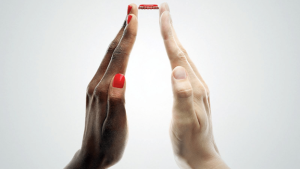
In addition to analyzing an advertisement’s rhetorical situation (who created it, for whom, and why) you can also analyze the rhetorical appeals that the ad uses in order to achieve its purpose. That is, what features of the ad make it persuasive? Again, you should refer to the chapter on “Writing Situations” in this textbook for more information about rhetorical appeals. A good place to begin, though, is to consider the use of ethos, pathos, and logos in an advertisement. You can consider:
- Ethos: How does the advertisement establish its credibility? Is there anything about the advertisement itself (its professionalism, its quality, its tone) that persuades viewers to accept its message? Is there anything about the creators or sponsors of the advertisement (their authority, their prestige) that persuades viewers to accept its message?
- Pathos: How does the advertisement speak to a viewer’s emotions? Does it try to make the viewer happy, angry, fearful, or distressed (among other possibilities) in order to affect the viewer’s judgment of the message?
- Logos: How does the advertisement use logical argument and support to communicate its message? Does it make reasonable claims? Are those claims supported with sound evidence?
To get some practice analyzing the rhetorical appeals of an advertisement, study the sample ad below. What can you determine about its use of ethos, pathos, and logos to persuade the viewer?
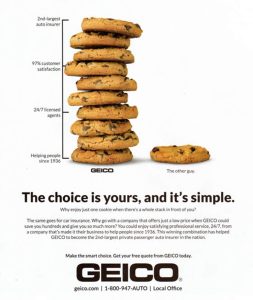
In many ways, analyzing the rhetoric of an advertisement is like analyzing the rhetoric of any text. It’s always important to think about the writer, purpose, audience, and exigence, as well as about rhetorical appeals like ethos, pathos, and logos. That said, there are special considerations to keep in mind when analyzing the rhetoric of an advertisement.
Advertisements are a genre quite unlike the other texts you’ll read and write about in College Composition, many of which are long-form academic essays. Advertisements are also different from the other visual genres discussed in this chapter, particularly when you think about how quickly ads are meant do their work. While we might spend an hour or more watching a film or several minutes contemplating a work of art, we usually just glance at a print advertisement or watch a few seconds of a commercial. In order to understand how an ad could possibly persuade a viewer in so short a time, we have to consider how they use features such as:
- Brief, catchy slogans or dialogue
- “Power words” that draw attention and elicit emotion (free, easy, exciting, delicious, etc.)
- Attention-grabbing fonts, images, and sounds
- Use of white space and color to quickly direct the viewer’s focus
- Foregrounding or repetition of key words, product names, or sponsors
- Use of name recognition or endorsement to establish authority
To get some practice analyzing how ads use these strategies, consider the sample ad below.
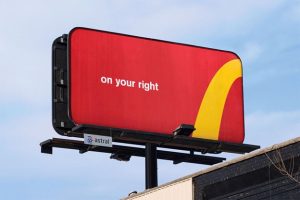
The Ideology of Advertisements
One of the most effective ways for an advertisement to persuade us is by appealing to our values and assumptions. We often support candidates and organizations whose ads support our own worldview, for instance. Similarly, we may purchase products because we believe our bodies, attitudes, and choices should resemble those of the models or spokespeople endorsing them. To fully understand how ads try to persuade us, it’s necessary to think about how they try to confirm our assumptions (or our fears) about ourselves, our culture, and our world.
Of course, even when the values and assumptions embedded in an advertisement are not part of a deliberate attempt to persuade us, it’s important to notice them and think critically about them. Advertisements are powerful. They’re everywhere. They can be flashy, provocative, and even fun. For these reasons, advertisements can normalize some beliefs (about race, for example, or body image or gender roles) and challenge or exclude others.
The critical theories already introduced in this chapter will help you to understand how the advertisements you analyze participate in our culture’s conversations about gender, race, class, and many other topics. You can find more information about these theories in this textbook’s chapter on “Literary Theory in the College Composition Classroom.”
An example of one scholar using critical theory (in this case, gender studies) to study advertisements is The Gender Ads Project by Scott A. Lukas. This site collects and analyzes advertisements in order to understand how they influence our ideas about gender and sexuality.
To practice thinking about how ads can reveal or even shape our assumptions about gender, consider the sample advertisement below.
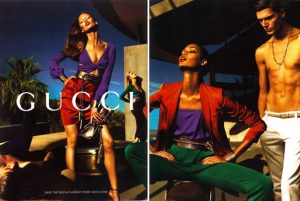
Writing Exercise: Analyze an Advertisement
Use the strategies for visual analysis that you’ve learned about in this chapter to analyze the rhetoric of a print ad or commercial of your choice. Compose an analysis that:
- Describes the advertisement using the visual and narrative elements discussed in this chapter.
- Explains the advertisement’s rhetorical situation and use of rhetorical appeals.
- Explains how the advertisement reflects or challenges prominent cultural ideas about gender, race, class, sexuality, disability, or any of the other cultural issues discussed in this chapter.
Continue Reading: 12.5 Analyzing Public Art: Descriptive Summary and Rhetorical Analysis
Composition for Commodores Copyright © 2023 by Mollie Chambers; Karin Hooks; Donna Hunt; Kim Karshner; Josh Kesterson; Geoff Polk; Amy Scott-Douglass; Justin Sevenker; Jewon Woo; and other LCCC Faculty is licensed under a Creative Commons Attribution-NonCommercial-ShareAlike 4.0 International License , except where otherwise noted.
Share This Book
Advertisement Rhetoric Analysis Essay
Inputting together an advertising campaign for a particular product or service, advertisers are typically only focused on how that advertisement can work to better promote their product or service over their competition. Most often, they are so focused on how to sell their product that they forget to pause and consider how their latest scheme might positively or negatively affect society. “Broadly speaking, the media exist in a very close, sympathetic relationship to power and established values. They favor a consensus view of any problem: they reflect overwhelmingly middle-class attitudes and experience” (Hall, 1974).
Subtle clues within the action or image can indicate how people react to specific behaviors that may be receiving a new definition thanks to the advertisements created. These types of advertisements frequently play on the side of dark humor, serving to entertain and retrain social standards at the same time. Occasionally, the effect a particular advertisement might have on the public is the primary focus of the ad with the product a perceived secondary reference.
In other cases, the focus remains on the product or service itself with the social message a secondary effect. To examine how rhetoric is used in advertising, two ads promoting weight loss are examined, one intended for an audience looking to lose weight the fast and effortless way from the Northern Bariatric Surgery Institute and the other intended to encourage people to eat healthier from the World Heart Foundation.
Both of these ads are focused upon weight issues and rely upon images to impart their message. “Inductive reasoning takes a specific representative case or facts and then draws generalizations or conclusions from them. Inductive reasoning must be based on a sufficient amount of reliable evidence, in other words, the facts you draw on must fairly represent the larger situation or population” (Weida, 2007).
The bulk of the message in both of these advertisements is contained in the image, striving to elicit emotional responses from their viewers. According to Weida (2007), emotional appeals are usually made to “paint a more legitimate and moving picture of reality or illuminate the truth.” While most associate these appeals with specific words, these advertisers rely on a combination of powerful images and few words used simply to direct the line of thought.
The first ad focuses on the center section of a supposed suicide bomber, complete with butter-stick bombs plastered across his chest and the accompanying words “Obesity is Suicide.” The second ad presents a human-scale mousetrap as a rustic table and the appeal to “open your eyes to saturated fat.” While the first of these advertisements is attempting to sell a service, bariatric surgery as a means of weight loss, the other is focused on a public health message. This difference becomes clear following rhetorical analysis.
The first advertisement features the image of an obviously overweight male torso. The hands of the man hold open a dark shirt to expose the T-shirt and wired double sticks of butter strapped around him like the sticks of dynamite a suicide bomber might use. The text of the ad proclaims “Obesity is suicide” and, in smaller letters “but it doesn’t have to end this way” (Northern Bariatric, 2008). This ad is taking the known fact that consuming large quantities of fat and cholesterol can lead to overweight and obesity as well as the known fact that obesity can lead to heart attack, stroke, and death and generalizing these to its ultimate end conclusion.
However, this ad has taken the slippery slope approach to rhetoric. The slippery slope “is a conclusion based on the premise that if A happens, then eventually through a series of small steps, through B, C,…, X, Y, Z will happen, too, basically equating A and Z. So, if we don’t want Z to occur A must not be allowed to occur either” (Weida, 2007). This mistake could have been avoided had the advertiser avoided the suggestion of an absolute. “We’ve all heard ‘never say never’; any totalizing statement is likely to result in a fallacy. But words like ‘don’t’ and ‘must’ creep in and can give a writer’s statements and indisputable air” (Myers, 1999).
The image/text combination suggests that obesity equals death with the same kind of immediacy one would feel upon facing a suicide bomber. As if the image itself were not scary enough, the associations encouraged by the text create an immediate personal threat and thus frightens the overweight person into researching the viability of the service offered.
The other advertisement presents a surprising image for the viewer depending upon how they first view it. At first glance, it can either appear to be a large mousetrap complete with a plate of appetizing cheese or it can be seen as a rustic dining table and chairs set with an appetizing plate of cheese as well as a suspicious metallic contraption. “Humor has a great way of defusing our critical faculties. Not that it’s bad in itself; it should just raise a red flag lest we go too far down the garden path on which someone wants to lead us” (Myers, 1999). The surprising nature of the image is brought into focus with the accompanying text, “Open your eyes to saturated fat” (World Heart Federation, 2008).
The two words ‘saturated fat’ is much larger than any of the other text on the page, facilitating an instant link between the concept of saturated fat and the dismal end of a mouse caught in a mousetrap. While somewhat humorous, the image is disconcerting as one contemplates the kind of animal that would be caught in this trap, and people begin to make connections with the way they sometimes feel about their food or weight. Thus, the rhetoric used in this advertisement depends upon the creation of an anecdote. Anecdotes “cast an issue in a favorable or unfavorable light, or can highlight or suppress certain aspects.
They work by suggesting a likeness between a character and the listener, or a situation and the listeners. What is emphasized or suppressed is key” (Myers, 1999). The advertisement avoids creating a rhetorical fallacy because it does not make any absolute claims. If you avoid the cheese enough, you may be able to avoid the snap of the trap, the snap of the trap may or may not kill its captive and there are obviously extenuating circumstances that may help one avoid the trap, such as if someone else were in the room as suggested by the second chair. The end message is one of warning and encouragement for smarter decisions rather than an insistence to rush out and buy a product.
A strong understanding of common rhetorical strategies used in advertising helps to understand how the advertisers are eliciting a particular response. Even when text is at a minimum and image is depended on for most of the message, rhetorical arguments can be traced. Understanding the inductive reasoning included in the above ads leads to further understanding of how this reasoning is either supported or negated by further rhetorical structures.
In addition, the inclusion of rhetorical fallacy in the Northern Bariatric advertisement can be seen to be an intentional exaggeration in order to develop a sense of urgency and immediacy. This sense of immediacy is hoped to drive greater viewer response resulting in higher profits for the company. The advertisement for the World Heart Federation, on the other hand, is able to focus on creating a strong and compelling argument without the need for exaggerating immediacy and instantaneous response. It is used as a means of communicating safer eating habits and encouraging viewers to consider carefully what they are about to eat.
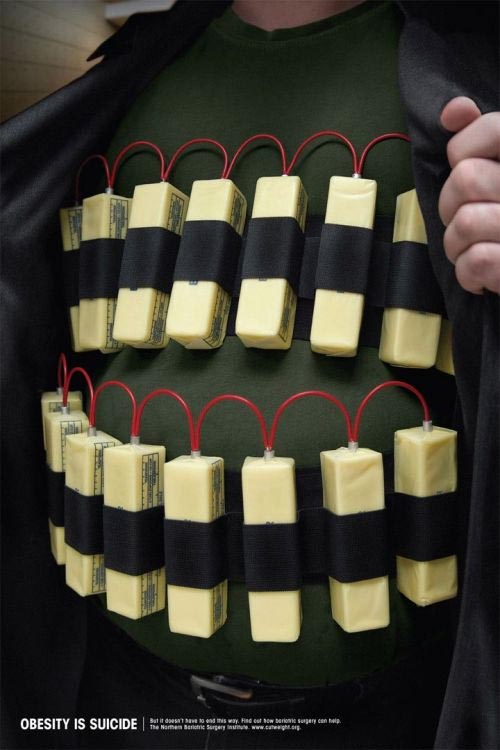
Hall, Stuart. (1974). “Black Men, White Media.” Savacou, Journal of the Caribbean Artists’ Movement. Vol. 9/10. Cited in “Revealed: How UK Media Fueled Race Prejudice.” (2001). Chronicle World. Web.
Myers, Gene. (1999). “Persuasive Words, Logical Fallacies and Intent Signals.” Rhetoric. Washington: Huxley College of Environmental Studies: Western Washington University. Web.
Northern Bariatric Surgery Institute. (2008). [Advertisement]. Web.
Weida, Stacy. (2007). “Using Rhetorical Strategies for Persuasion.” The Owl at Purdue. Purdue University. Web.
World Heart Federation. (2008). [Advertisement]. Web.
- Children’s Suggestibility in Forensic Interviewing
- Post-Operational Care in Diabetic Bariatric Surgery
- The Bariatric Surgery Center
- Advertising Principles from Consumer Perspective
- Advertising Ethics: Principles and Practices
- Non-Traditional Advertising in the Modern World
- Media Advertising Ethics and Self-Regulation
- Erving Goffman’s Codes of Gender in Advertisement
- Chicago (A-D)
- Chicago (N-B)
IvyPanda. (2021, October 10). Advertisement Rhetoric Analysis. https://ivypanda.com/essays/advertisement-rhetoric-analysis/
"Advertisement Rhetoric Analysis." IvyPanda , 10 Oct. 2021, ivypanda.com/essays/advertisement-rhetoric-analysis/.
IvyPanda . (2021) 'Advertisement Rhetoric Analysis'. 10 October.
IvyPanda . 2021. "Advertisement Rhetoric Analysis." October 10, 2021. https://ivypanda.com/essays/advertisement-rhetoric-analysis/.
1. IvyPanda . "Advertisement Rhetoric Analysis." October 10, 2021. https://ivypanda.com/essays/advertisement-rhetoric-analysis/.
Bibliography
IvyPanda . "Advertisement Rhetoric Analysis." October 10, 2021. https://ivypanda.com/essays/advertisement-rhetoric-analysis/.

Lisa's E-Portfolio
A publish.illinois.edu site.

Rhetorical Analysis Essay
Want a sweet date? Get Corolla!
Advertisement is a handy tool for companies or organizations to promote their products, service or ideas, etc. Image advertisement may include a lot of information into one piece of flyer. Besides creative promoting ideas, target audience and values companies or organizations trying to share to their viewers are also important elements of an advertisement.
While I was doing my research online, an interesting TOYOTA image advertisement caught my attention. The only image in the advertisement is a white female who is about twenty-five to thirty years old. The image only shows her face and her shoulder. It seems like she is sitting and putting her arms on a desk while her hands are holding her face. Her face expression shows that she enjoys taking this photo because she is smiling gently. There are two messages with big and bold letters around her image saying “I once kissed a guy on the first date” and “I drive a Corolla.” There is also a message with smaller letters at the left bottom corner saying “Interesting cars for interesting people” and a TOYOTA logo on the right bottom corner.
The thesis of this car advertisement is that TOYOTA is trying to promote people to buy their Corolla because it is a nice and interesting car. The support of the thesis would be the text and the image showed in the advertisement. “I once kissed a guy on the first date” shows that the woman is brave and decisive. She is the type of person who is not afraid to take the risk to grip what he/she wants. Now she drives a Corolla. Similar to her date, she takes a risk now to try Corolla. By looking at the woman’s face expression, we can tell she is satisfied about what she gets – her date and Corolla. Her smile indirectly proves TOYOTA’s claim. The woman is not regretting buying a Corolla, and you will not regret if you get one as well. By saying “Interesting cars for interesting people”, TOYOTA categorizes Corolla as interesting and special cars. If you own a Corolla, you are fashionable, special, and you have a good taste. So why not get one?
The warrants of this advertisement would be spirit of adventure and fun. The warrants are not directly stated in the advertisement. However, since TOYOTA believes that kissing a guy on the first date is a good try, we can imply that TOYOTA believes their consumers like to take risks to experience new products as well. Customers are excited to try exciting stuff and have fun. TOYOTA also assumes that people like to be considered interesting and special. If majority of the population just want to be “normal” not “interesting”, then the text “Interesting cars for interesting people” will be pointless. TOYOTA is selling a typical adventurous life style.
The qualifier of this advertisement can be an issue. This advertisement gives people a sense that this car is only for those people who like to take a risk. However, from our common knowledge, we know TOYOTA is a famous Japanese brand and is well know for its good product quality. For those of people who do not know much about TOYOTA, about Corolla, this advertisement could be misleading. Some potential customers may be scared away just by reading this advertisement. On the other hand, the image of the woman enlarges the range of potential consumers. The woman in the advertisement is pretty, but not as sexy as many other female images we see from other advertisements today. Comparing to other super models, this woman is a “normal” person, just like you and me. It is trying to promote an idea that Corolla can be for anyone.
More and more advertisements today start to use the idea of sex to attract people’s attention on their products. Does driving a car necessarily have a connection with having a date? Probably no. However, when I first read this advertisement, I felt it was so reasonable, and the message really made sense to me. Why? One may argue that because this is what is happening in the reality and this is the truth. However, did people accept the same idea twenty years ago? Fifty years ago? A hundred years ago? The idea in the advertisement itself could be a qualifier. Older people may not accept this idea at all. Even my dad has concern about “kissing a guy on the first date”, and he is just 53 years old. Thus, this advertisement is limited to target fairly young population by its own promoting idea.
Some people may not agree on taking a risk. They may value safety and their lives on the first place instead of fun while driving. One indirect rebuttal in this advertisement would be the use of a female image. Female are usually characterized as loving and caring. Female drivers often drive carefully, slowly and safely. If Corolla can satisfy her, then there should be no problem for those who do not like taking risk to try Corolla. There is not really a backing in this advertisement. However, one possible backing TOYOTA could add into this advertisement would be safety measurement. Giving statistics to show customers that their cars are safe is the most direct and efficient way to back up possible safety concerns. Customers can have fun and be safe at the same time. Adding statistics will also make this advertisement more competitive. Consumers can quickly compare Corolla to other cars and make their decisions.
People view tons of advertisements every day on newspaper, magazines and Internet, etc. It is important for people to understand the elements of an advertisement and the tricks it is using. People should beware of details and not be bamboozled.
* References will be provided under tab “Works Cited”.
Rhetoric & Civic Life – Wiley
137h, section 11: words, words, words….

Sample Rhetorical Analysis Paper
This is not a “perfect” paper, but it’s a decent example of a Rhetorical Analysis of a recent ad:
Lance Armstrong and Nike
Nike, Inc. has traditionally been a brand suited for competitive athletes, with its origins rooted in selling athletic shoes, but eventually expanded to sell clothing and gear to athletes and non-athletes alike. Nike has adapted its advertisement campaigns to reach its eclectic audience by sponsoring globally renowned athletes such as Lance Armstrong. Despite the fact that cyclists are in the minority in society, the campaigns involving Lance Armstrong have been particularly persuasive, proving that though a viewer may not have a direct athletic kinship to a celebrity endorser, he may still be greatly influenced by the celebrity’s advertisement message. By focusing on Armstrong’s public revelation of stage three testicular cancer, this advertisement proved itself to be emotionally powerful, broadly inclusive of its audience, and auspiciously released at a time to meet the needs of the company. In addition to emotion, kairos was also undeniably a substantial component to the effectiveness of the ad; it appeared after Armstrong had not only recently defeated cancer, but continued on to win several Tour de France races, elevating him to a lofty status comparable to a hero. Also, Nike was enveloped in public turmoil over alleged unethical manufacturing practices, and the company attacked this rhetorical exigence with this ad. This short but enthralling commercial uses Armstrong’s confession to broaden Nike’s rhetorical and consumer audience, to grip the viewer with a potent amount of pathos to shift negative connotations away from its products, and to promote its brand by aligning Nike with Armstrong’s victory over cancer.
Opening with Armstrong’s public revelation of his case of testicular cancer, the advertisement immediately establishes its pathetic appeal, as the image of an emotional Armstrong emotionally engages the viewer. The vulnerability of such a strong figure in American society, especially one renowned for enduring grueling long-distance cycling races, is a striking means of capturing the attention and sympathy of the viewer. Nike also uses text as an implicit technique employed to dramatize the impact of the message and to reiterate the extent of Armstrong’s condition. Not only does it reinforce the severity of his condition, but it also underscores the fact that Armstrong is so swept with emotion that he cannot bear to finish the sentence. It provides time for the viewer to dwell on the words and their grim connotation. Also, this opening reaches a wide audience, as the emotional devastation of a cancer diagnosis is a commonplace that would be able to reach an expansive scope of viewers. It would resonate with anyone that has been affected by cancer, instead of simply fans of Armstrong or the sport of cycling. As the commercial continues with Armstrong’s assertion that he intends to beat the disease and ride again as a professional athlete, Armstrong looks up into the camera, the only point at which he does so throughout the entire commercial. This too adds to the commercial’s pathos, as it allows a more personal connection to be made with the audience. It also makes his vow to overcome his affliction that much more prominent, which will become a crucial asset for the marketing power of Nike.
Immediately following the emotionally charged climax of the ad, Armstrong’s pledge to defeat cancer, Nike segues into the widely recognizable “Just do it” slogan, and the classic swish logo. This strategic placement insinuates the integration of the corporation and Armstrong’s struggle and eventual victory over his ailments, and the realization of his dream to continue his professional career. This aligns Nike’s legendary phrase with the now legendary success and determination of Lance Armstrong. It emboldens the audience to believe that purchasing Nike products is inextricably correlated to fighting cancer and personal battles. To further elucidate this connection, Nike places yellow lettering against a black background, and its swish logo in black against a yellow background. The use of these colors alludes to Armstrong’s LiveStrong Foundation, which raises awareness and funding for cancer treatment, support, and research. This reaffirms Nike’s unity with the charity foundation in the mind of the viewer.
This commercial would also broaden Nike’s appeal to a mass audience, as it promotes the shared common ideology in the resiliency of the human spirit. By drawing a parallel between its products and triumph over a crippling disease, Nike exploits the natural tendency of people’s desire to conquer their own personal trials and injects the belief of the attainability of any achievement, with the help of Nike products, into the viewer. This too invokes a great deal of pathos, as it invigorates and motivates the viewer to want to take action and emulate the achievement of Armstrong. The placement of Nike’s logo after Armstrong’s affirmation to beat the disease and continue cycling, both of which have been fulfilled, causes the viewer to cognitively associate Nike as the means to attaining his own personal success.
Understanding the context of this advertisement is crucial to fully grasp how kairos played a pivotal role in this rhetorical situation. In the early 2000s, when this ad was first published, Lance Armstrong was at the height of his fame for doing the impossible in two different realms: overcoming what appeared to be a fatal diagnosis of cancer, and subsequently winning numerous Tour de France races after his cancer treatment was finished. Nike elicited the grandeur of Armstrong’s respected status in society to promote its brand. In contrast to this valiant glory, Nike was undergoing a firestorm of public denouncement and criticism amidst a sweatshop scandal. Outcries over Nike’s use of factories that use sweatshop labor and pay wages below subsistence levels caused many groups to insist that sports teams, universities, and stores sell other brands besides Nike that don’t use unethical practices. Nike utilized the ad and the ethos and credibility of Armstrong’s pristine character to appease its desperate need of positive publicity and to re-establish its public image. Nike’s use of yellow and black themed lettering and texts display the company’s sympathetic view towards cancer, and remind the audience of the major support Nike had given to the LiveStrong foundation. The rhetorical exigence of Nike’s need to affirm its preeminent status was solved by connecting Armstrong’s beloved appeal to Nike’s signature slogan, logo, and company as a whole.
In just one 30 second commercial, Nike was able to catapult itself from a limited audience and a disgruntled labor movement to attaining full attention from the community and restoring the public’s faith in the brand. It employed Lance Armstrong’s illustrious stature and acclaimed victory over illness and competition to propel its status to a company engaged in the laudable task of supporting cancer treatment. It not only parlays the message to viewers that they can achieve success, but motivates and impels them to utilize Nike products to realize their goals. The commercial’s use of pathos allows it to broaden its audience to not just cyclist fans or sports fans, but to anyone who has either dealt with cancer or faces what seems to be an insurmountable task. It utilizes common ideologies and values of triumph over obstacles and the hope of extraordinary accomplishments to engage a wide audience. This pervasive and emotionally enticing advertisement was wisely used by Nike to impress upon an eclectic and comprehensive audience of the company’s positive role in society and compel the viewer to support the brand. By affirming universal appeals, by invoking pathos, and by displaying its connection to a heroic cause, Nike captures support from its audience and seizes the present rhetorical situation.
2 thoughts on “ Sample Rhetorical Analysis Paper ”
Pingback: What to Analyze in Summary and Analysis and a Word about Thesis | Adventures in Writing and Rhetoric
Pingback: How to Write a Rhetorical Analysis Essay on a Commercial
Leave a Reply Cancel reply
You must be logged in to post a comment.
Rhetorical Analysis Sample Essay
Harriet Clark
Ms. Rebecca Winter
13 Feb. 2015
Not Quite a Clean Sweep: Rhetorical Strategies in
Grose's "Cleaning: The Final Feminist Frontier”
A woman’s work is never done: many American women grow up with this saying and feel it to be true. 1 One such woman, author Jessica Grose, wrote “Cleaning: The Final Feminist Frontier,” published in 2013 in the New Republic, 2 and she argues that while the men recently started taking on more of the childcare and cooking, cleaning still falls unfairly on women. 3 Grose begins building her credibility with personal facts and reputable sources, citing convincing facts and statistics, and successfully employing emotional appeals; however, toward the end of the article, her attempts to appeal to readers’ emotions weaken her credibility and ultimately, her argument. 4
In her article, Grose first sets the stage by describing a specific scenario of house-cleaning with her husband after being shut in during Hurricane Sandy, and then she outlines the uneven distribution of cleaning work in her marriage and draws a comparison to the larger feminist issue of who does the cleaning in a relationship. Grose continues by discussing some of the reasons that men do not contribute to cleaning: the praise for a clean house goes to the woman; advertising and media praise men’s cooking and childcare, but not cleaning; and lastly, it is just not fun. Possible solutions to the problem, Grose suggests, include making a chart of who does which chores, dividing up tasks based on skill and ability, accepting a dirtier home, and making cleaning more fun with gadgets. 5
Throughout her piece, Grose uses many strong sources that strengthen her credibility and appeal to ethos, as well as build her argument. 6 These sources include, “sociologists Judith Treas and Tsui-o Tai,” “a 2008 study from the University of New Hampshire,” and “P&G North America Fabric Care Brand Manager, Matthew Krehbiel” (qtd. in Grose). 7 Citing these sources boosts Grose’s credibility by showing that she has done her homework and has provided facts and statistics, as well as expert opinions to support her claim. She also uses personal examples from her own home life to introduce and support the issue, which shows that she has a personal stake in and first-hand experience with the problem. 8
Adding to her ethos appeals, Grose uses strong appeals to logos, with many facts and statistics and logical progressions of ideas. 9 She points out facts about her marriage and the distribution of household chores: “My husband and I both work. We split midnight baby feedings ...but ... he will admit that he’s never cleaned the bathroom, that I do the dishes nine times out of ten, and that he barely knows how the washer and dryer work in the apartment we’ve lived in for over eight months.” 10 These facts introduce and support the idea that Grose does more household chores than her husband. Grose continues with many statistics:
[A]bout 55 percent of American mothers employed full time do some housework on an average day, while only 18 percent of employed fathers do. ... [W]orking women with children are still doing a week and a half more of “second shift” work each year than their male partners. ... Even in the famously gender-neutral Sweden, women do 45 minutes more housework a day than their male partners. 11
These statistics are a few of many that logically support her claim that it is a substantial and real problem that men do not do their fair share of the chores. The details and numbers build an appeal to logos and impress upon the reader that this is a problem worth discussing. 12
Along with strong logos appeals, Grose effectively makes appeals to pathos in the beginning and middle sections. 13 Her introduction is full of emotionally-charged words and phrases that create a sympathetic image; Grose notes that she “was eight months pregnant” and her husband found it difficult to “fight with a massively pregnant person.” 14 The image she evokes of the challenges and vulnerabilities of being so pregnant, as well as the high emotions a woman feels at that time effectively introduce the argument and its seriousness. Her goal is to make the reader feel sympathy for her. Adding to this idea are words and phrases such as, “insisted,” “argued,” “not fun,” “sucks” “headachey,” “be judged,” “be shunned” (Grose). All of these words evoke negative emotions about cleaning, which makes the reader sympathize with women who feel “judged” and shunned”—very negative feelings. Another feeling Grose reinforces with her word choice is the concept of fairness: “fair share,” “a week and a half more of ‘second shift’ work,” “more housework,” “more gendered and less frequent.” These words help establish the unfairness that exists when women do all of the cleaning, and they are an appeal to pathos, or the readers’ feelings of frustration and anger with injustice. 15
However, the end of the article lacks the same level of effectiveness in the appeals to ethos. 16 For example, Grose notes that when men do housework, they are considered to be “’enacting “small instances of gender heroism,” or ‘SIGH’s’—which, barf.” 17 The usage of the word “barf” is jarring to the reader; unprofessional and immature, it is a shift from the researched, intelligent voice she has established and the reader is less likely to take the author seriously. This damages the strength of her credibility and her argument. 18
Additionally, her last statement in the article refers to her husband in a way that weakens the argument. 19 While returning to the introduction’s hook in the conclusion is a frequently-used strategy, Grose chooses to return to her discussion of her husband in a humorous way: Grose discusses solutions, and says there is “a huge, untapped market ... for toilet-scrubbing iPods. I bet my husband would buy one.” 20 Returning to her own marriage and husband is an appeal to ethos or personal credibility, and while that works well in the introduction, in the conclusion, it lacks the strength and seriousness that the topic deserves and was given earlier in the article. 21
Though Grose begins the essay by effectively persuading her readers of the unfair distribution of home-maintenance cleaning labor, she loses her power in the end, where she most needs to drive home her argument. Readers can see the problem exists in both her marriage and throughout the world; however, her shift to humor and sarcasm makes the reader not take the problem as seriously in the end. 22 Grose could have more seriously driven home the point that a woman’s work could be done: by a man. 23
Works Cited
Grose, Jessica. “Cleaning: The Final Feminist Frontier.” New Republic. The New Republic, 19 Mar. 2013. Web. 28 Mar. 2014.
- Article author's claim or purpose
- Summary of the article's main point in the second paragraph (could also be in the introduction)
- Third paragraph begins with a transition and topic sentence that reflects the first topic in the thesis
- Quotes illustrate how the author uses appeals to ethos
- Analysis explains how the quotes show the effective use of ethos as noted in the thesis
- Transition and topic sentence about the second point from the thesis
- Quote that illustrates appeals to logos
- Analysis explains how the quotes show the effective use of logos, as noted in the thesis
- Transition and topic sentence about the third point from the thesis
- Quotes that illustrate appeals to pathos
- Analysis explains how the quotes show the effective use of pathos, as noted in the thesis
- Transition and topic sentence about fourth point from the thesis
- Quote illustrates how the author uses appeal to ethos
- Analysis explains how quote supports thesis
- Transition and topic sentence about fourth point from thesis
- Conclusion returns to the ideas in the thesis and further develops them
- Last sentence returns to the hook in the introduction
Learn more about the " Rhetorical Analysis Graphic Organizer ."
Learn more about " Pathos, Logos, and Ethos ."

Rhetorical Analysis Of An Advertisement Example
In order to analyze the rhetoric of an advertisement, we must first understand what rhetoric is. Rhetoric is “the art of using language to persuade”. In other words, it’s all about how words are used to influence or affect an audience.
When it comes to advertising, rhetoric is used in order to sell a product or service. Advertisers use carefully chosen words and images in order to create an emotional response in their audience. This response can be positive (I want that!) or negative (I need that!). Either way, the goal is to get people to take action, whether that’s buying a product or simply paying attention to the ad.
Let’s take a look at a recent ad featuring a woman. This ad is for a new brand of jeans, and the woman in the ad is shown wearing them. The ad copy reads: “The perfect fit for every body. Finally, a jean that looks good on you.”
There are several things going on here rhetorically. First, the use of the word “perfect” is meant to create a sense of desire in the reader. We all want to look perfect, so this ad is playing on that insecurity. Second, the word “every” is inclusive language that makes us feel like this product is meant for everyone. And lastly, the phrase “looks good on you” is designed to make us feel good about ourselves. It’s a way of saying that no matter what your body type is, you can look good in these jeans.
So, what can we learn from this ad? Advertising is all about persuasion, and advertisers use rhetoric to achieve their goals. By understanding how rhetoric works, we can be better consumers and make more informed decisions about the products and services we buy.
There are an innumerable number of different advertisements on the internet. They’re all over the place, whether it’s on TV, radio, or in a magazine. They’ve created an ad especially for that target demographic. Of course, they’re hoping to sell their goods. This billion-dollar industry thrives on advertisers looking at every angle to capture consumers’ attention. One approach used to promote items is through sex, which some people view as controversial in certain ways.
In this essay, I will be analyzing a perfume advertisement that uses a woman’s body to sell the product.
This particular advertisement is for the new scent from the company Givenchy. The ad features a close-up of a woman’s face with smoky makeup and red lips. Her hair is styled in big, loose curls. She’s wearing a black leather jacket with nothing else. The copy on the ad reads, “Givenchy Dahlia Noir. A dangerous femininity.” Immediately, we can see that they’re trying to sell the idea of a strong, sexy woman who is also dangerous.
Looking at the image alone, we can see that they’re using sex appeal to sell their product. The close-up of the woman’s face and the suggestion of her bare chest implies a sexual nature. The black leather jacket is also a symbol of sexiness and power. Combined with the copy, it’s clear that they’re trying to sell the idea of a dangerous femme fatale.
While there is nothing wrong with using sex appeal in advertising, it’s important to consider the context in which it’s being used. In this case, Givenchy is selling a perfume that is supposed to make women smell sexy. There’s nothing wrong with that. However, they’re using a very specific image of a woman to sell their product. They’re not just selling the idea of smelling good, they’re selling the idea of being a certain type of woman.
The target demographic is males and females in their late teens to mid-twenties. By attracting the attention of and interest in the attractive woman on the right with vivid colors, as well as the bottle of whiskey in the middle of the page, this firm captures the male side of the equation. The beauty of this picture is that it has an exceptionally attractive lady posing in next to nothing, which attracts people’s attention.
The fact that she is not wearing a lot of clothing shows that this company does not shy away from showing some skin to get attention, but they are also using a very popular drink among men, whiskey. This company has used a model that is guaranteed to keep the attention of their target market, males in their late teens to mid twenties.
The second thing this company does well is use pathos by saying ” be seen with the right crowd.” What they are trying to say is that if you drink their whiskey then you will be accepted into the “in-crowd” and become popular. This is an emotional appeal that speaks to people who want to be accepted and feel like they belong somewhere. This is a very effective way to get people to buy their product because it is speaking to a very real emotion that people feel.
The last thing this company does well is use logos by saying ” smooth like silk.” This is a way of saying that their whiskey is the best on the market and that it is so smooth that it feels like silk going down your throat. This is an effective way to get people to buy their product because they are saying that their whiskey is better than any other kind on the market.
So, to get women to look at and read their advertising, they employ a plain woman who looks like a typical young girl. Then, beside her, they display the same lady who is now a stunning woman that seems far more powerful and certain of herself. Drinking Evan Williams Kentucky straight bourbon whiskey might help you accomplish that.
This is because Advertising plays a very big role in our society, especially when it comes to alcohol. It is shown in this advertisement that if you drink Evan Williams you will become more attractive and just be an all around better person. This is not only directed at females but also males as well. Advertising does a lot to our society good and bad. It helps promote products but sometimes those products are things that can be harmful like cigarettes or alcohol. So while advertising does have its benefits, it is important to be aware of what we are being sold and the implications it might have on our lives.
In conclusion, this company uses three different kinds of rhetoric to appeal to their target market of males in their late teens to mid twenties. They use an attractive model to get their attention, pathos to speak to their emotions, and logos to appeal to their sense of logic. All of these things together make for a very effective advertisement.
More Essays
- Kindle Advertisement Analysis Essay
- Victoria’s Secret Advertisement Analysis Essay
- Male Body Advertisement Analysis Essay
- Essay on Amnesty International Advertisement Analysis
- Primus Advertisement Analysis Essay
- Similarities Between Tipalet And Virginia Slims
- Sex In Advertising Essay
- Covergirl Advertisement Analysis Essay
- Propaganda Techniques In Advertising
- Advertisement Analysis Of ‘Got Milk?’ Essay
Leave a Comment Cancel reply
Save my name, email, and website in this browser for the next time I comment.

Home — Essay Samples — Business — Nike — Rhetorical Analysis of ‘want It All’ Advertisement by Nike
Rhetorical Analysis of ‘want It All’ Advertisement by Nike
- Categories: Advertisement Nike
About this sample

Words: 477 |
Published: May 19, 2020
Words: 477 | Page: 1 | 3 min read
Works Cited
- Armstrong, L., & Foddy, M. (Eds.). (2013). The Routledge Handbook of Sport Expertise. London, UK: Routledge.
- Bloyce, D., & Smith, A. (Eds.). (2010). The Social Impact of Sport: Cross-Cultural Perspectives. London, UK: Routledge.
- Nike. (2017). Nike Want It All - Full Version. Retrieved from https://www.youtube.com/watch?v=obdd31Q9PqA
- Pritchard, A., & Morgan, N. (2017). Advertising in Tourism and Leisure. Wallingford, UK: CABI.
- Schmitt, B., & Rogers, D. (2018). Handbook on Brand and Experience Management. Cheltenham, UK: Edward Elgar Publishing.
- Shank, M. D. (2010). Sports Marketing: A Strategic Perspective. Upper Saddle River, NJ: Pearson Education.
- Slack, T., & Parent, M. M. (Eds.). (2005). Experiential Learning in Sport Management: Internships and Beyond. Morgantown, WV: Fitness Information Technology.
- Smith, A. C., & Stewart, B. (Eds.). (2010). Sporting Cultures: Global Perspectives. New York, NY: Routledge.
- Thompson, J. L., & Sullivan, A. P. (2018). Sport Public Relations and Communication. New York, NY: Routledge.
- Walters, G., & Trenberth, L. (2016). The Political Economy of Sport. London, UK: Routledge.

Cite this Essay
Let us write you an essay from scratch
- 450+ experts on 30 subjects ready to help
- Custom essay delivered in as few as 3 hours
Get high-quality help

Verified writer
- Expert in: Business

+ 120 experts online
By clicking “Check Writers’ Offers”, you agree to our terms of service and privacy policy . We’ll occasionally send you promo and account related email
No need to pay just yet!
Related Essays
3 pages / 1157 words
3 pages / 1168 words
3 pages / 1398 words
5 pages / 2156 words
Remember! This is just a sample.
You can get your custom paper by one of our expert writers.
121 writers online
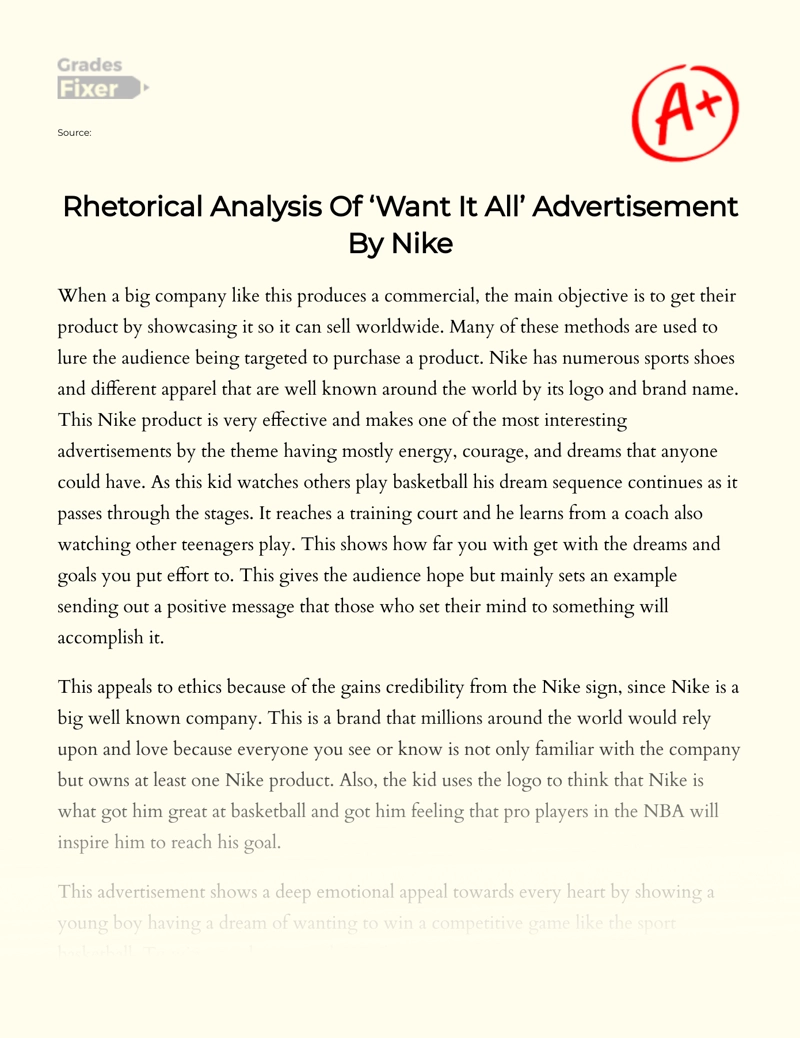
Still can’t find what you need?
Browse our vast selection of original essay samples, each expertly formatted and styled
Related Essays on Nike
The Vermont Teddy Bear Company is a well-known American company that specializes in creating handmade teddy bears. The company has been in business for over 35 years and has gained a strong reputation for its high-quality [...]
The marketing mix, also known as the 4Ps, is a foundational concept in marketing that helps businesses to effectively market their products or services. The marketing mix consists of four key elements: product, price, place, and [...]
In the era of modern globalization, few brands have achieved the level of global recognition and influence as Nike. The iconic swoosh logo has become synonymous with sportswear, athleticism, and a global consumer culture. Nike's [...]
When you think of athletic apparel and footwear, one name that undoubtedly comes to mind is Nike. With its iconic swoosh logo and innovative products, Nike has become a household name synonymous with sports and fitness. But [...]
This text is questioning why men are looked as being the superior athletes in comparison to women in sports, and more specifically in long distance running. It also questions why we as society feel the need to compare them. The [...]
Nike, one of the world's most iconic sportswear brands, has mastered the art of market segmentation to effectively target diverse consumer groups. With its innovative products and powerful marketing strategies, Nike has [...]
Related Topics
By clicking “Send”, you agree to our Terms of service and Privacy statement . We will occasionally send you account related emails.
Where do you want us to send this sample?
By clicking “Continue”, you agree to our terms of service and privacy policy.
Be careful. This essay is not unique
This essay was donated by a student and is likely to have been used and submitted before
Download this Sample
Free samples may contain mistakes and not unique parts
Sorry, we could not paraphrase this essay. Our professional writers can rewrite it and get you a unique paper.
Please check your inbox.
We can write you a custom essay that will follow your exact instructions and meet the deadlines. Let's fix your grades together!
Get Your Personalized Essay in 3 Hours or Less!
We use cookies to personalyze your web-site experience. By continuing we’ll assume you board with our cookie policy .
- Instructions Followed To The Letter
- Deadlines Met At Every Stage
- Unique And Plagiarism Free
We use cookies to enhance our website for you. Proceed if you agree to this policy or learn more about it.
- Essay Database >
- Essay Examples >
- Essays Topics >
- Essay on Appeal
Example Of Essay On Rhetorical Analysis Of Advertisements
Type of paper: Essay
Topic: Appeal , Basketball , Audience , American Sports , Middle East , Sports , Public Relations , Advertisement
Words: 2500
Published: 02/18/2020
ORDER PAPER LIKE THIS
Advertisement refers to a form of communication and marketing strategy employed to manipulate, persuade, and convince consumers or a particular group of people to adapt a new course of action or continue with their previous behavior. The main goal of employing advertisement is to change consumer behavior, beliefs, and values towards a particular product or service with the aim to increase the sales volume, profit margin, and market niche. In most cases, people presume that advertising/advertisement means to sell, but this is not the case because advertisements inform and notifies consumers about various products available in the market. However, how do advertisers persuade, convince, encourage, and appeal consumers/ audience to purchase particular products/services or pursue a given course of action? Before answering this question, it is worthy acknowledging that advancement in science and technology has transformed the world of advertisement largely. Advertisers not only use media such as televisions and radios to air their commercial advertisements, but also employ internet, facebook, twitter, and other form of social networking sites. Technology also allows advertisers to design and create appealing and catchy 3-Dimension advertisements, which have high graphic resolutions, and incorporate animated advertisements. Although advertisers use media, internet, and social media to appeal, persuade, and convince the audience, they include various rhetoric tools/means namely: pathos, logos, ethos, kairos, examples, comparison-contrast, and cause-effect in the advertisement in order to elicit the intended effect on the audience. The paper discusses the use and analysis of rhetoric tools (pathos, logos, ethos, and kairos in these two advertisements: “Maybe it’s my fault- Jordan commercial-become a legendary”, and TNT NBA playoffs open 2009: Games of Kings.
Aristotle refers rhetoric as the available tools of persuasion that one uses to appeal, persuade, and convince others to undertake a particular course of action. Most advertisements mainly focus on the use of various means of persuasion when attracting, luring, and appealing consumers to purchase certain products and services; an idea that increases sales volume and profit margin of the business (Hesford & Brueggemann, 2007). Broadly speaking, rhetoric tools are not only used in advertisements, but also in other areas as envisioned on the advertisements of TNT NBA playoffs open 2009: Games of Kings, and Maybe it’s my fault-Jordan commercial-become a legendary. The advertisement entitled, “Maybe it’s my fault-Jordan commercial-become a legendary”, starts with Michael Jordan (a renowned and famous legendary in basketball) holding a basketball in his hands and in an anticipation to score. In the advert, one can see Michael Jordan advising, talking, coaching, and appealing the audience (in this case, a group of young boys with the desire and passion in basketball) to learn tactic, skills, and expertise required to become a legend in basketball. The theme of the advertisement appeals to the youths to value, appreciate, and work hard towards achieving their goals in life and become a legendary in basketball. The advertisement features Michael Jordan narrates his personal experience, victory, drawbacks, and suffering while striving to become a basketball legend. The audience can see the narrators suffering, mastering of skills, drawbacks, and personal resilience towards playing basketball through the use visual rhetoric means, especially the use of 3-Dimension media. The advertisers have used modern media and technology to appeal the youths to play basketball, built their resilience, determination, power, energy, and confidence towards the game. During the narration, Michael Jordan posses a series of rhetoric questions (maybe I) coupled with body movements to elicit a conviction effect that is evident through facial expression of the audience. In the narration, Michael Jordan concludes that he maybe changed the game or the “boys,” are making excuses about the same.
Rhetoric analysis of Michael Jordan advertisement
While analyzing this advertisement, it remains clear that the concept of ethos has been used effectively to appeal and persuade the target group. Ethos means the fundamental ability and art to use another person’s character and credibility to persuade others (Rosengren, 2013). In other words, one uses his/her character to win the consumers trust and authority over a given concept. In most cases, the target group or consumers tend to believe a character who demonstrates high level of expertise, skills, and knowledge, and good will than a character with low level of knowledge about a given concept. In this scenario, ethos emanate from the people behind the advertisements especially the players and narrators, who show that they understand, have skills, competences, and knowledge needed to play basketball. In the case Jordan-commercial advertisement, Michael Jordan (the narrator) uses the words, “Maybe it’s my fault that I changed the game,” to affirm his mastery of basketball. This aspect convinces the audience that when they follow the words and advice of Michael Jordan they will become legendaries in basketball; an aspect that prevail in narrator’s voice. In essence, the narrator persuades the audience by justifying his words through a personal experiences thus winning trust and authority over the target group. In the advertisement, it is evident that the audiences (young players) are attentive to the narrator’s advice because the former believe they will become basketball legends when they follow Michael Jordan advice. Based on this assertion, players tend to believe on the narrators words, experiences, personal observation, and reflections because Michael Jordan remains a legend in basketball. The advert has also integrated the concept of logos in the analysis. Logos refers to presentation of facts, counter claims, logic reason, and evidence in an argument. In the case of Jordan-commercial advertisement, the narrator poses a premise, “Maybe it’s my fault that I made you believe that it was easy when it was not,” but Michael Jordan persuades the audience by providing personal accounts to substantiating this predisposition. In this scenario, the narrator concludes that t-shirts he wore, but rather on hard word, resilience, and determination did not determine his legend. The players (audience) tend to believe on the narrator because facts, evidence, and logic reasoning are embodied in the advertisement. The audience can connect ideas, thoughts, predisposition presented by the advertisers to evaluate logic, and facts associated with the advertisements, and influence their decision towards basketball. The advertisement embodies logical and rational narrations, facts, and evidence to support claims raised by Michael Jordan in the advertisement thus persuading the audience effectively. It is imperative for advertisers to support their argument, presentation, and claims by providing concrete and reliable evidence; an idea that prevails in this advertisement. Pathos is one of the rhetoric tools, which is envisioned and embodied in Michael Jordan advertisement. Pathos refers to emotions and values of the target group and efforts of the character/rhetoric to elicit the emotions on the audience and acknowledge the values. For instance, in the case of Michael Jordan advertisement, the narrator persuades the audience using compassion and love feelings. The narrator states that, “your focus, determination, and resilience speak louder about your achievements and success on the game.” This shows that the narrator is concerned and compassionate over the audience and urges them to inculcate these characters. In the analysis, the narrator portrays basketball as a game that requires players’ to hold and subscribe to certain principles, values, and characters; an idea that promotes professionalism. In normal scenario, audiences are easily convinced and persuaded when they watch an advert that conveys values, principles, and characters, which they treasure and value. In the same breath, audience focus on advertisements, which elicits compassionate emotions to their audience; an aspect that prevails in this advertisement. Kairos remains embodied in the advertisement as illustrated in Michael Jordan narration. Kairos refers to the opportune or correct time and place to strike an argument. In other words, a persuasive argument may not yield positive results because it is not timely and suitable for a given place. In this scenario, the advertisement has considered these features as envisioned in the analysis and narration. The advertisers provide a historical background that sets the premise and favorable environment to persuade the audience. In the advertisement, the narrator strikes a persuasive argument with the audience/players in a basketball pitch because the narrator (Michael Jordan) holds the view that audience would connect with his idea, advice, and predisposition while playing the game. This aspect promotes relevance of the advertisement and persuades the audience. This fact allows the audience to relate the past events with the current aspects and weight over the significance on each event. Other development strategies including comparison-contrast have been used to design the advertisement. The idea behind comparison-contrast strategy is to reveal the uniqueness of the object in question over the other, and in this case, it focuses on basketball and chase games. In the case of Jordan advertisement, the narrator echoes the words, “failure you gave me strength, my pain you gave me motivation.” Such words contradict each other in meaning, but they appeal and persuade the audience to be confident and patient while playing basketball; an idea that is evident in commercial advertisements.
Analysis of advertisements on Games of kings
The advertisement of TNT NBA playoff opens 2009: Games of Kings, features players playing chase and basketball, which are referred as “games of kings.” The advert reveals determination, resilience, skills, competences, and techniques required to emerge a win in chase and basketballs. The advert elaborates on technical skills, which players need to use to attack their opponents. The advertisement articulates that winning “games of kings” need combination and mastering skills, rules, and exhibition of high level of confidence and determination. The narrator urges players to balance their emotion because emotions either exalts or lowers a man’s spirit to win the game In the advertisement, the advertisers have incorporated various rhetoric tools including ethos, pathos, logos, and kairos, to persuade, convince, and appeal to the audience. In the advertisement, the concept of ethos is evident when the narrator states that the first moment does not require movement, but a look on the opponent’s eye; an idea that portrays the narrator as a competent, experienced, and skillful of the game. In this aspect convinces players to maintain an eye contact with the opponents to facilitate one’s chance to become a winner. The narrator uses tonal variation to create different effects and elicit emotions on the audience; an idea that enables the audience trust and believes that, indeed, chase and basketball are games of kings. Additionally, the advertisement portray ethos by using energetic, determined, and confident players who confirm that chase remains a game of kings thus changing character of the game in question. All the players featuring on the advertisement are portrayed as being strong, stern, focused, and determined; an idea that makes the audience believe that anyone playing the games of kings should posses these characters and personality traits. This aspect appeal and persuade the audience because they believe and trust the advertisers as being genuine and trustworthy. The advertisement embodies the concept of logos in its analysis. In this scenario, the narrator appeals to the audience by showing crowds of spectators watching and cheering players play chase and basketball. This creates emotions and reveals that indeed chase and basketball remain games of kings; played by competent, skilled, and experienced players. The narrator use real life examples to show the outcome of mastering various skills of the game by using the words such as “attack, retract, and employ tactics hence persuading the players to remain focused when playing games of kings; a move that further appeals and convinces the audience. Eliciting positive or negative emotions on the audience remains an imperative component in advertising. This aspect is embedded in the manner in which, the advertisers integrate concept of pathos in narration and analysis. The narrator uses negative feelings including anger and fear to persuade the players. This is evident when the narrator states that, “emotions can raise a man or can lower a man.” This means that players/audience needs to maintain a balance their emotion to avoid downfall and propel their victory. Normally, players/ audiences who would not maintain their emotional balance would be destined to a downfall in the game. In the business arena, advertisers use fear and negative emotions to urge consumers to continue purchasing and using particular products/services by conveying negative effects that results from using certain products/services. The advert has integrated the concept of kairos to appeal, persuade, and convince the audience. In the advertisement, the narrator explains the importance of focusing on time when playing the game; an aspect that is evident when the author states, “be mindful of time and do not clock authority over your reason.” This move encourages the players to pay attention to the time aspect prior launching an attack towards the opponent to avoid poor calculation and defeat. The narrator articulates that failure to observe time may affect the outcome of the game and de-motivates players/audience. Advertisers should consider time factor when appealing and convincing their consumers/ audience to create immerse impacts on the intended target population. Narration remains an indispensible component in advertisement as illustrated in the advertisement. The audience and purpose of the advertisement determined the type of voice or tonal variation that the narrator employs in appealing the audience. In the advertisement, the advertisers use calm, stern, and low voice to advise, persuade, and appeal the players to master skills of playing basketball and chase game. In the same breath, the narrator uses the tool of tool variation to elicit feelings, shared values, and compassion to connect with the audience and appeal them to value chase and basketball. The advertisement embodies pictorial and graphical illustrations to reinforce the effects of the words and tonal variation employed by the narrator; an idea that is evident from the audience facial expression. In conclusion, it is clear that rhetoric tools of persuasion play a crucial role in appealing, convincing, and encouraging the target group takes a course of action as envisioned in these two advertisements.
Works cited
. Hesford, W. S., & Brueggemann, B. J. (2007). Rhetorical visions: reading and writing in a visual culture. Upper Saddle River, N.J.: Pearson/Prentice Hall. MAYBE IT'S MY FAULT - Jordan Commercial - Become Legendary - YouTube. (2012, February 4). YouTube. Retrieved October 16, 2013, from http://www.youtube.com/watch?v=_-EyRUgp9Mk TNT NBA Playoffs Open 2009: Game of Kings - YouTube. (n.d.). YouTube. Retrieved October 16, 2013, from http://www.youtube.com/watch?v=UwPk9_TEdaQ Rosengren, S. (2013). Advances in advertising research. Wiesbaden: Springer Gabler

Cite this page
Share with friends using:
Removal Request

Finished papers: 2924
This paper is created by writer with
ID 282482737
If you want your paper to be:
Well-researched, fact-checked, and accurate
Original, fresh, based on current data
Eloquently written and immaculately formatted
275 words = 1 page double-spaced

Get your papers done by pros!
Other Pages
Example of motor vehicle parts import course work, example of top three social issues in the united states today essay, the relationship between racism racialised punishment and the construction of asylum critical thinking examples, free benefits policy essay sample, a little about myself essay example, differences between biblical and systematic theology article review, good example of wechsler intelligence scale for children wisc essay, discharge plan essay samples, the first ever 2014 cadillac elr poolside essay examples, india versus japan course work, pollution is killing the earth course works example, human resource development essay samples, good essay about health care strategies, fed up summary essay samples, free course work on alzheimers disease, free essay about greek religion journal article critique, koffler essays, fausta essays, efron essays, lambrecht essays, martella essays, deserted island essays, supportive role essays, the disabled students essays, false hope essays, industrial and organizational psychology essays, human technology essays, racial contract essays, sexual anatomy essays, transportation planning essays, vito corleone essays, wise move essays, first confession essays, subtropical ridge essays, ma joad essays, cookie research papers, ansel adams research papers, catcher in the rye research papers, charles manson research papers, hiking research papers, gratitude research papers, black swan research papers, a white heron research papers.
Password recovery email has been sent to [email protected]
Use your new password to log in
You are not register!
By clicking Register, you agree to our Terms of Service and that you have read our Privacy Policy .
Now you can download documents directly to your device!
Check your email! An email with your password has already been sent to you! Now you can download documents directly to your device.
or Use the QR code to Save this Paper to Your Phone
The sample is NOT original!
Short on a deadline?
Don't waste time. Get help with 11% off using code - GETWOWED
No, thanks! I'm fine with missing my deadline

Rhetorical Essay
Rhetorical essay generator.

In the realm of persuasive writing, rhetorical essays stand as powerful demonstrations of linguistic artistry. By employing a variety of literary devices, carefully selected words, and strategic communication techniques, these essays are designed to sway the minds and emotions of readers. Delving into the heart of rhetoric, this article will delve into the essence of rhetorical essays, guiding you through their creation while offering illuminating examples and practical tips. Whether you’re a seasoned writer or new to the craft, understanding the dynamics of a rhetorical essay can enhance your ability to communicate effectively and convincingly.
1. Rhetorical Analysis Essay Template
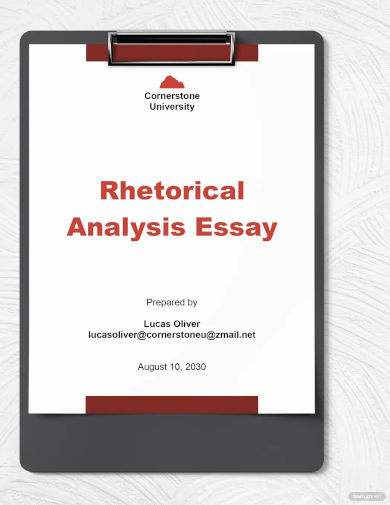
- Google Docs
2. Rhetorical Essay Outline
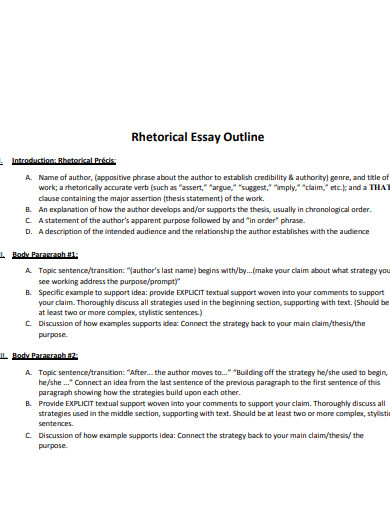
Size: 345 KB
3. Structure of Rhetorical Analysis Essay
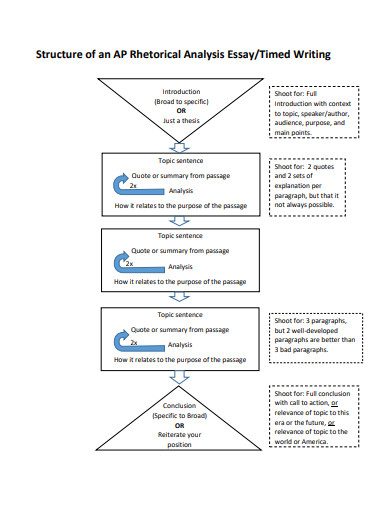
Size: 315 KB
4. Rhetorical Analysis Thesis Statement Essay

Size: 342 KB
5. Editable Rhetorical Essay

Size: 133 KB
6. Rhetorical Analysis Essay Outline
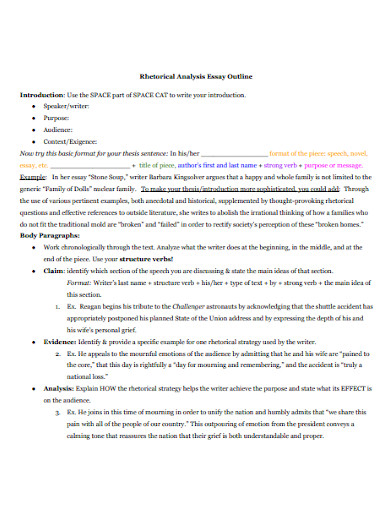
Size: 60 KB
7. Sample Rhetorical Essay
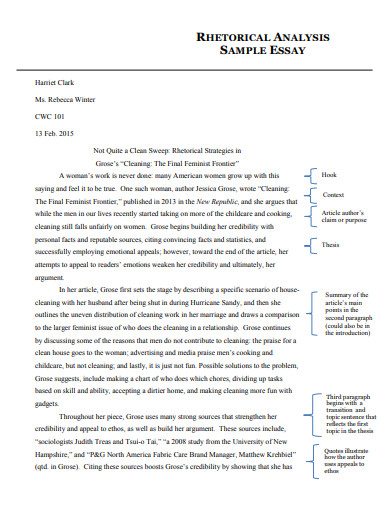
Size: 341 KB
8. Rhetorical Essay Template
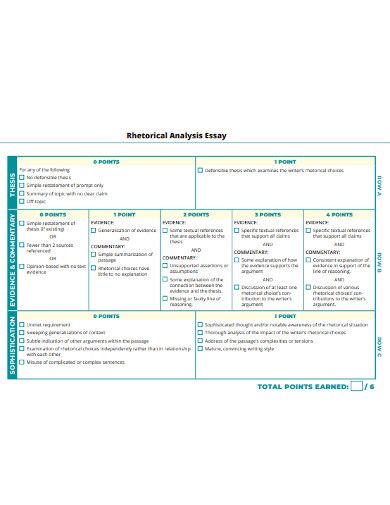
Size: 77 KB
9. Rhetorical Essay Ethos

Size: 544 KB
10. Rhetorical Essay Layout
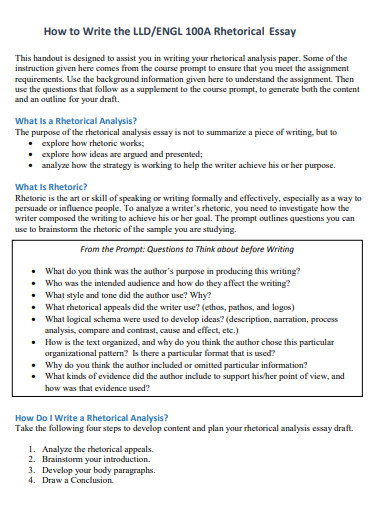
Size: 424 KB
11. Rhetorical Essay Paper
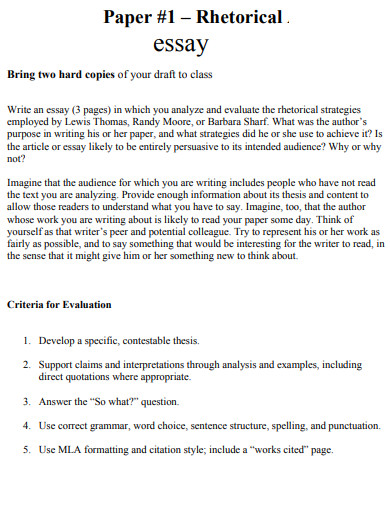
Size: 666 KB
12. Organizing and Outlining Rhetorical Essay
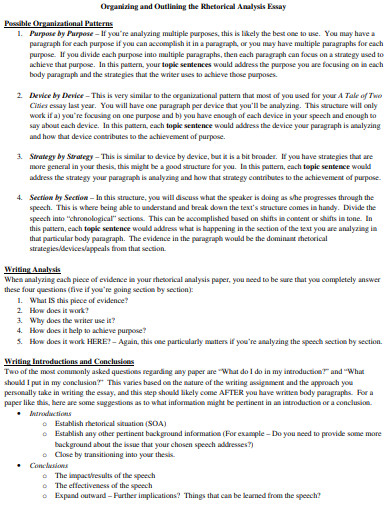
Size: 23 KB
13. Rhetorical Essay Rubric

Size: 10 KB
14. Rhetorical Grading Essay
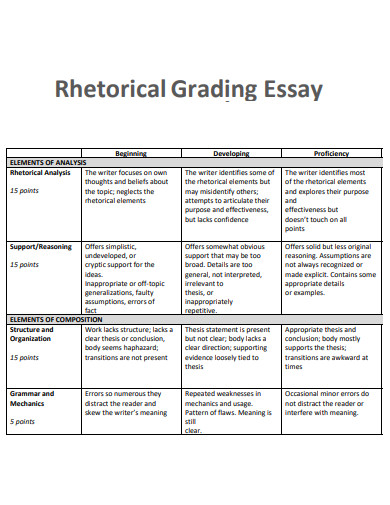
Size: 134 KB
15. Rhetorical Essay Informative Writing
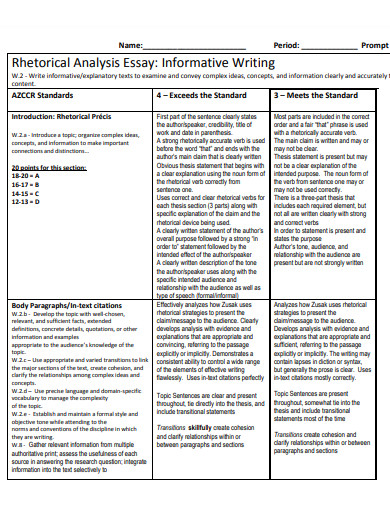
Size: 350 KB
16. Simple Rhetorical Essay

Size: 35 KB
17. Critical Rhetorical Essay
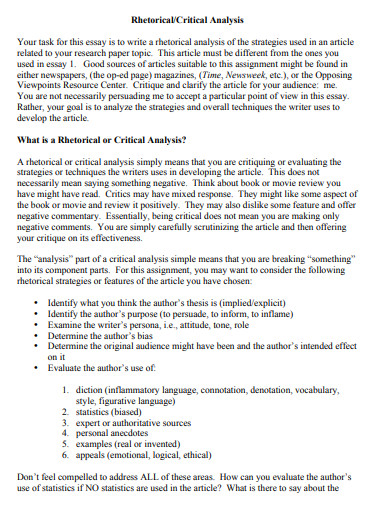
Size: 61 KB
18. Research Rhetorical Essay
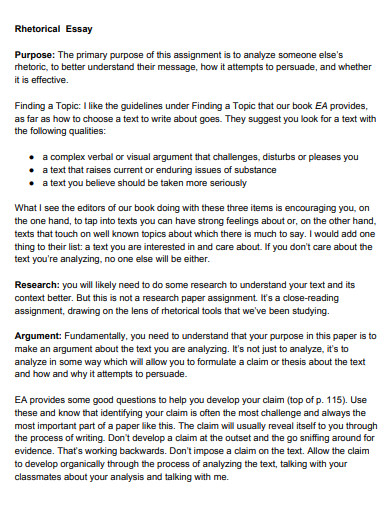
Size: 112 KB
19. Rhetorical Essay Reference
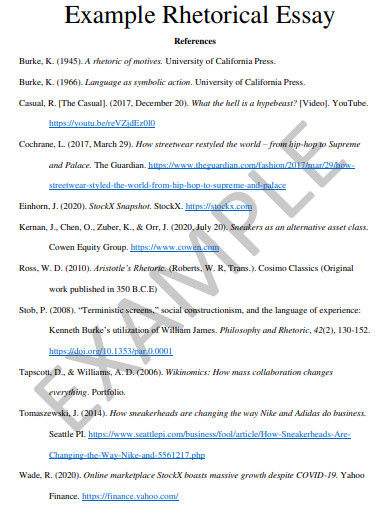
Size: 174 KB
20. Rhetorical Essay Worksheet
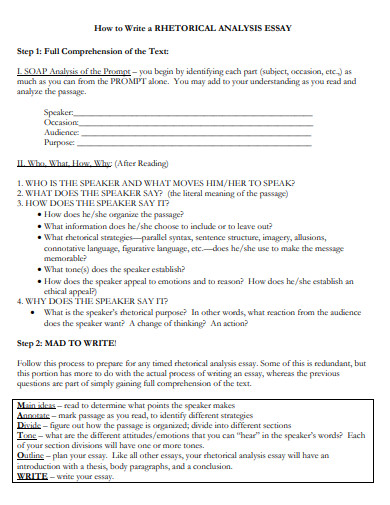
Size: 303 KB
21. Rhetorical Essay on Gender Equality
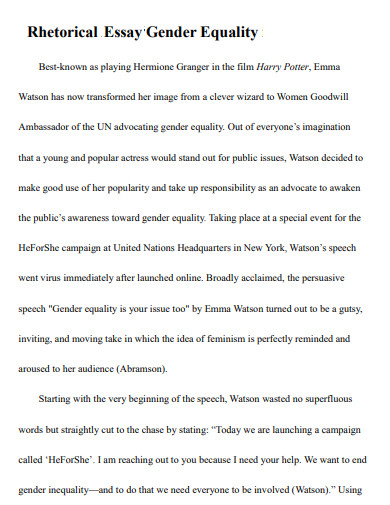
Size: 224 KB
22. Formal Rhetorical Essay

Size: 82 KB
23. Rhetorical Essay Format
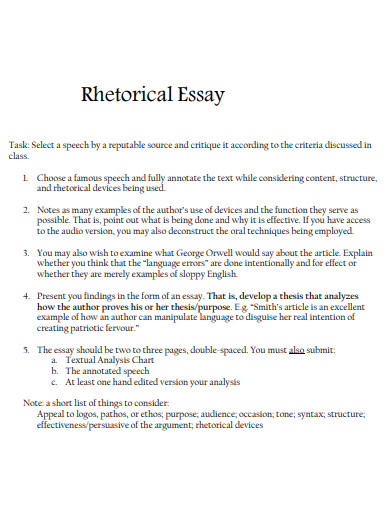
Size: 128 KB
24. Professional Rhetorical Essay
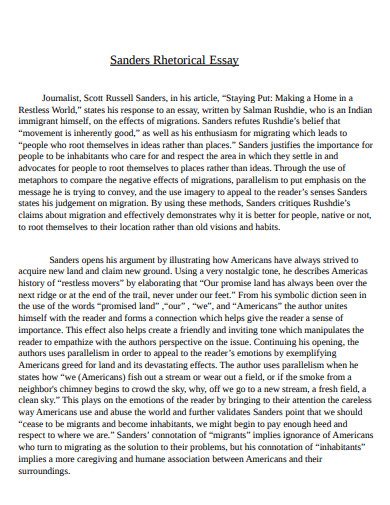
Size: 26 KB
What is a Rhetorical Essay?
A rhetorical essay is a unique form of discourse that employs persuasive techniques to communicate a particular message or viewpoint. This literary device operates by leveraging linguistic elements to convince an audience of the validity of a certain argument or perspective. Unlike traditional essays that primarily focus on information and analysis, rhetorical essays emphasize the art of persuasion. By dissecting the behaviors of words, examining their impact within a specific context , and avoiding clichés , a rhetorical essay creates an objective and compelling narrative that leaves a lasting impression.
How to write a Rhetorical Essay
Creating a compelling rhetorical essay requires a meticulous approach that blends creativity with strategic communication. To navigate this intricate process, let’s break it down into several key steps that will help you weave together a convincing and impactful piece.
Step 1: Choosing a Subject and Objectives
Begin by selecting a topic that resonates with your audience and aligns with your objectives. Consider the behaviors you intend to evoke and the elements you wish to emphasize. Craft an overarching objective that defines the purpose of your essay, whether it’s to inform, persuade, or provoke thought.
Step 2: Mastering Language and Syntax
Leverage the power of verbs , adjectives, and proper nouns to create a vivid and captivating narrative. Use observation to your advantage, painting a detailed picture that engages your readers’ senses. Employ simple sentences to convey your ideas clearly and concisely, ensuring that your message remains accessible.
Step 3: Employing Rhetorical Devices
Rhetorical essays thrive on the skillful use of literary devices . Incorporate metaphors, similes, and analogies to add depth and resonance to your arguments. Harness the strength of repetition and parallelism to reinforce key points and create a rhythmic flow that captivates your audience.
Step 4: Structuring for Impact
Organize your essay with a clear structure that guides your readers through a logical progression of ideas. Begin with a strong introduction that sets the tone and context, followed by well-organized body paragraphs that present evidence, analysis, and persuasive elements. Conclude with a compelling ending that reinforces your main points and leaves a lasting impression.
What is the most important element of a successful rhetorical essay?
The choice and skillful implementation of rhetorical devices, such as metaphors and analogies, can significantly enhance the impact of your essay.
Can I use humor in a rhetorical essay?
Yes, humor can be a powerful tool in persuasion, but ensure it aligns with your objective and doesn’t undermine the seriousness of your message.
How do I avoid sounding manipulative in my rhetorical essay?
Focus on transparency and authenticity. Present your arguments with integrity and provide solid evidence to support your claims, avoiding any overt manipulation.
In the realm of persuasive writing, rhetorical essays serve as a testament to the power of words. By delving into the behaviors of language, harnessing the art of rhetoric, and crafting a narrative that engages and convinces, you can create essays that leave a lasting impact. So, whether you’re aiming to provoke thought, inspire action, or challenge perceptions, remember that a well-crafted rhetorical essay can be your most potent tool in the realm of written persuasion.
Text prompt
- Instructive
- Professional
Write a rhetorical essay analyzing the speech given by Martin Luther King Jr.,
Examine the use of ethos, pathos, and logos in a popular advertisement of your choice in a rhetorical essay.

Read a Transcript of Volodymyr Zelensky’s Interview With The Times
The Ukrainian president spoke to Times reporters in Kyiv for nearly an hour.
During the interview on Monday, President Volodymyr Zelensky said that Russia was massing more troops and forces on the border. Credit... Daniel Berehulak/The New York Times
Supported by
- Share full article
President Volodymyr Zelensky of Ukraine spoke to the Times journalists Andrew Kramer, Philip P. Pan and Bill Brink for 50 minutes at the presidential office in Kyiv on Monday. Anastasia Kuznietsova provided translation.
This transcript of the interview has been edited and condensed for clarity.
Q. The Biden administration has prohibited Ukraine from using American-made weapons to strike inside Russia, out of concern for escalation, including the risk of nuclear war. Your government has urged a change. Given the situation on the battlefield, how should this policy change, and why?
First of all, the Biden administration was indeed against the use of Western weapons. Today, we have our own weapons, our own drones, and we use them, but I would like to note that we do this for defense. This is very important, and what we have always asked of President Biden — and not only President Biden, but the leaders of many countries — is that we want to use the weapons for defense.
When there are attacks from Russian territory targeting civilians exclusively, and artillery is firing exclusively at civilians, when artillery strikes a city, the city center — that’s how it happens — you can’t respond to them because of the range of your artillery. We don’t have long-range shells. You must understand that for the last year and a half, Ukraine hasn’t had any long-range shells.
How do we respond when they strike our cities? They are stationed in the villages nearest to the border of Ukraine in Russia. They strike from there, knowing that we will not return fire, knowing that they are using civilian populations as cover, because their weapons are located among the civilian population of the Russian Federation. But they proceed calmly, understanding that our partners do not give us permission, as you said.
And here, when we talk about ATACMS or HIMARS, or we talk about artillery shells, or relevant missiles — Storm Shadow, Scalp, etc. — we do not have permission to strike the territory of the Russian Federation, their military locations, headquarters, etc. This is part of our defense. How can we protect ourselves from these attacks? This is the only way.
It is the same for air defense. How can we protect ourselves from constant strikes by guided bombs, various missiles, etc., from Russian territory? They strike with missiles from Russian territory, up to 100 kilometers away from a point in Ukraine or the border of Ukraine. How can we protect ourselves?
We can either strike the missile that is entering Ukrainian territory or strike the aircraft before launch. To strike the missile, we need air defense. To strike the aircraft, we need appropriate weapons — weapons and permission.
‘They Will Come to Us With Death’
Q. Do you feel there’s something about the situation that you face on the battlefield right now that makes this request more urgent?
The recent Kharkiv example shows that when you understand and have information — thanks to our partners who share some intelligence, especially satellite data — you know that along the border, Russia is massing troops and forces. Trains bring in equipment, tanks and armored vehicles, etc. They unload in the Belgorod region, among other places. They are unloading there, and you know that it’s happening.
This means that tomorrow, they will not come with flowers. They will come to us with death. Right? Right. When they move from where they are massing to 10 different places, for example, in the Kharkiv region, I have a question: If we know that tomorrow they will come not to celebrate but to kill us, why can’t we use weapons to destroy them where they are massing?

This would also help because they wouldn’t be united in a single operation. They would know that if they accumulate at a particular point, we will strike.
It’s like a fence, a fence before they cross our border. But it’s a fence of fire. Because this is a different war — modern, hybrid — and you can’t say that only a real physical fence, a trench, or minefields will work. No. It’s a complex action — if you have weapons that can at least reach the border with Russia.
And if we cannot reach those areas, what can we say about the places where their equipment masses on Russian territory? This is their huge advantage. The shelling of Kharkiv, all the deaths of people, children — this is their huge advantage. The daily use of bombs — this is their huge advantage. The use of S-300 systems — they have accumulated 10,000 S-300 missiles. Ten thousand — this is their advantage again.
Are there suitable weapons in the world to counter this? Yes. Are there suitable weapons better than what Russia has in its arsenal? Yes. Does Ukraine have both of these elements — sufficient quantity and permission? No.
Q. Have you asked permission from the Biden administration?
I asked for permission from Secretary of State [Antony] Blinken. I sent signals to [National Security Adviser Jake] Sullivan. I spoke through various contacts and intelligence channels, and to the administration of the president. And at the same levels, leaders of other allied countries, European Union states, received such signals from me.
‘No Risks of Escalation’
Q. What do you say to the people who argue that it is too risky to allow Ukraine to use these weapons inside Russia because of the risk of escalation?
There are no risks of escalation. Escalation has already occurred: Russia’s escalation against Ukraine.
It’s like sanctions. They talk about the risk of economic escalation with Russia. This shows that our partners are afraid, in principle, of completely severed relations with the Russian Federation.
When you sanction Russian businesses and withdraw yours from their market, it’s a sanction that works 100 percent. If sanctions cannot be bypassed, you prohibit any accounts, banking systems, freeze Russian capital located in the territory of a particular country altogether.
If you freeze, for example, their capital, does frozen Russian capital on E.U. territory help E.U. society? No. Do they use this money? No. Do they receive this money as assistance to people? No. Do they benefit from this money? No. It is frozen. Yes, but they do not transfer this money to Ukraine. Why? Let’s find the answer together: Because it would mean a total rupture of economic relations with the Russian Federation.
It’s similar to embassies. Did everyone close their embassies? No. Did everyone send Russian diplomats home from their countries? No. Did they recall their ambassadors from a state that is a terrorist? No. And so diplomatic sanctions — were they applied 100 percent? No.
Therefore, we cannot say that we have pressured Russia diplomatically or economically through sanctions. No. Because there was no total rupture. Why? They’re afraid of being left without diplomatic ties with the Russian Federation. Isolation has not occurred.
And now we move on to the issue of weapons. Nothing here is different. Why can’t Ukraine be given the ability to use them? You will be told that it’s escalation. No. It’s a complete rupture of any relations with the Russian Federation. Everyone keeps the door slightly ajar with Russia. Slightly ajar. Not as open as it was after 2014, when there was a big mistake. But each of the leaders left them slightly open. Not everyone, but many. Just a crack. “What if Ukraine loses? We should not close the doors completely with Russia.”
Putin and Nuclear Weapons
So, when it comes to escalation and nuclear weapons, and all these narratives that Russia speaks of — you know, he’s an irrational person. Because a rational person cannot unleash a full-scale war against another state. He’s irrational, or he knew that there would be no consequences for him, which means there was discussion with other countries. And I don’t even want to think about it because then it’s not partnership, it’s playing behind each other’s backs, and it’s betrayal, complete betrayal.
So let’s say that he didn’t have any agreements, and he’s just an irrational person who decided that nobody would defend Ukraine and he could invade and destroy us.
So then he could have used nuclear weapons. When he failed to capture us in the first year of the war, he didn’t use them — because he may be irrational, but he loves his own life very much and understands that the doors will be completely closed, completely, if he uses nuclear weapons. Because the use of nuclear weapons is not a red line. It’s a different level. So that’s it. This is World War III.
So, tell me, what could be a greater escalation than mass killings of people in Ukraine?
Food as a Russian Weapon
Q. You’ll be holding peace talks next month in Switzerland, and the month after that, NATO leaders will be gathering in Washington. What do you hope to achieve from each of these meetings? Regarding peace talks, these are indirect talks, talks with partners. Under what conditions would you begin direct talks with Russia, and what role would you see for China in a peace settlement?
The peace summit is based on the formula proposed by the Ukrainian side. We have outlined in our plan what challenges we see.
Unblocking the sea — food security — let’s be honest, did anyone, apart from deep analysts of this war, understand how much harm blocking the Black Sea would bring to the African continent? What price dumping there would be on agriculture? And that Russia would do this dumping by blocking the Black Sea and transporting its agricultural products to Asia, Latin America, Africa, etc., and selling them at a much higher price? And they are also politically deciding with this or that African country what will happen there, what the policies will be, how they should treat the E.U. countries and the United States, who they should maintain relations with and whose to sever.
So it has become a weapon. Food products have become a kind of weapon for the African continent. There are chemical weapons they used on our territory, and there is a weapon like this, which can lead to famine in one or another country.
We understand deeply the crises that this war has brought, and, therefore, we propose our plan. The peace summit will involve a large number of countries. It is very important to address the first three points, three points that can bring all the countries of the world together.
One point is food security. What I mentioned in part about agriculture and the blockade of the Black Sea, the Azov Sea, there are challenges there and so on.
Hostages at a Nuclear Plant
The second issue will be nuclear security — energy. This is very important. Who knows what is really happening at the nuclear power plant in the city of Enerhodar? Who really knows the details? But we know. The IAEA knows.
It is mined. There is weaponry there. There are armed individuals from the Russian Federation, mercenaries or military. There are Ukrainian citizens working at the plant who, for the first year, constantly sent us information about the situation there. There has never been danger like this before. If we remove them from there tomorrow, that station will definitely collapse. It will be a risk for everyone. Six reactors. It’s like six Chernobyls. How can there be military forces there? They don’t want to leave, they won’t give it up voluntarily. They don’t want to. But they’re afraid that the station will explode, so our people work there.
Here’s another argument. The personnel of Rosatom who managed this operation and are currently managing this station — why haven’t sanctions been imposed on them? What’s the problem? Although the fact is absolutely confirmed here, absolutely confirmed, that they have occupied the station and are holding everyone hostage. All the people working there are hostages. You know, it’s a fact, proven, that the children of people working at this station have been taken to Russia. They are hostages. That’s why they work at the station, because their children have been taken away.
And the third point is the [prisoner-of-war] exchange of “all for all,” as well as the return of deported children. This third point is humanitarian.
If we support resolving all three crises separately, responsible countries will gather at a technical level and develop a plan that we will support.
I believe if we develop a detailed plan to address these three points, it needs to be handed over to representatives of the Russian Federation. And when they see that, for example, 60, 80, 100 countries believe it’s a fair plan, well, then we’ll see if Russia wants to end the war. And we’ll see if the world wants the war to end on fair terms, not on what a person in the Kremlin sees.
On NATO Troops in Ukraine
Q. We’ve reported that NATO is considering sending instructors to Ukraine to train Ukrainian forces. Other NATO countries have discussed sending troops to Ukraine. Would you welcome either move?
This is an independent decision for each state, including NATO countries. Undoubtedly, as a country at war, we would positively welcome any assistance, and we would support such a decision.
It’s true that no one has offered us anything yet. The first signals came through the media. They came from France, from Emmanuel Macron. We talked with him about what he means. There’s logic in two things that I definitely understood. This includes training on Ukrainian territory, simply speeding up the process, without having to send your brigade somewhere else, to one country or another, and then it returns. And there’s also the need for adaptation time here in the conditions of war.
Yes, training here is faster, building repair hubs for equipment is faster. But there are a lot of media words behind this. So far, this idea hasn’t gone anywhere. I don’t see it, except in words. But, nonetheless, how can anyone be against this? We are only in favor.
And then they talk about the troops. I don’t quite understand yet how this corresponds to reality and whether it’s true, and whether it’s possible, etc. I am grateful, again, for the boldness of Emmanuel, etc., but it’s necessary to understand what he’s really willing to do, what can be and how it can help us.
‘Shoot Down What’s in the Sky’
I asked, can we first shoot down — from the territory of a NATO country, from the territory of our neighbors — the missiles flying towards our energy facilities, without crossing into Ukraine’s airspace?
Technically, all of this is possible. Shooting down Russian missiles already in Ukrainian territory, from their planes. This is what we saw in Israel. Not even on such a large scale.
If you’re shooting down missiles targeting our energy facilities, you can deploy your planes. You already do. You should know that NATO countries are already deploying them because the missiles are heading towards our Western partners. For example, the gas network in western Ukraine, and missiles heading in that direction. Our neighbors are already deploying planes anyway.
So my question is, what’s the problem? Why can’t we shoot them down? Is it defense? Yes. Is it an attack on Russia? No. Are you shooting down Russian planes and killing Russian pilots? No. So what’s the issue with involving NATO countries in the war? There is no such issue. It’s defense.
Tomorrow, all these missiles will fly into these countries. Don’t doubt it. It’s just a matter of time. Why not shoot down the missiles? Where’s the involvement in that? When we talk about NATO countries discussing troops on Ukrainian territory, these are living people. I’m just responding to you, let’s take the first practical step. Shoot down what’s in the sky over Ukraine. And give us the weapons to use against Russian forces on the borders.
Q. Did you ask Mr. Macron this?
About the aircraft? No, I’m going to talk about it, but I asked other partners. I conveyed to all key partners that I believe it’s fair to shoot them down with aircraft.
Let’s agree: The Russian Federation has a fleet with 300 aircraft that the Russian fleet uses against Ukraine. Three hundred aircraft. Our analysis told us that we need 120 to 130 F-16s or aircraft with high technical characteristics.
Let’s agree: If Ukraine doesn’t receive such a quantity of aircraft for various reasons, why can’t a smaller number of aircraft located in NATO countries close our airspace? This is a reasonable option for today until we have F-16s. Not just that, I would say, until we have a number of F-16s adequate to the Russian fleet. Because when you only have a small number of F-16s, it’s undoubtedly insufficient to counter significant, serious attacks in many cases.
‘Can We Get Seven?’
The Washington summit, I did not answer about the Washington summit.
Q. I had another question, but let’s hear about the Washington summit with NATO.
I want practical solutions. I would really like us to get an invitation [to join NATO], because I know that this would be a very serious card in Ukraine’s hands before the end of the war. Although I believe that when this card is in Ukraine’s hands, it is also in the hands of the United States and other partners, and even those who are not in NATO. Those who are Russia’s neighbors, and those who are concerned about their security. Because everything can change completely.
Those who today believe that Russia will never attack them, and those who consider themselves economic partners will become its enemies tomorrow. Wasn’t it like that with Ukraine? Weren’t we their main friends? Were we not their main market? Were they not our main trading partner? Families, friends, economy, geography, security, everything. And now we are 100 percent enemies.
So this card is not only in our hands. This is change. A change in geopolitical security in our region. I believe this will have an impact on the whole world. So I would like specifics, an invitation.
Yes, this is a political instrument. However, this doesn’t mean we are in NATO. And we are not pushing. We understand that if there is an invitation, we will only discuss NATO membership after the war. We understand all the arguments. There will be no pressure from our side.
But everyone says that this is escalation — again. I believe that the U.S. and Germany are not ready for this. Right? Right.
Then we can eventually get seven Patriot systems from NATO countries? Seven. We would like to close the airspace over all our regions and have 20 to 30. Let’s forget about that. Can we get seven? Do you think it is too much for the NATO anniversary summit in Washington? For a country that has been trying to become a NATO member since 2008? For a country that is fighting for freedom and democracy around the world today? Seven systems. This is just the practical result of the summit.
And an American decision to give us its F-16s. Because without them, Ukraine will not have a fleet of 130 aircraft. It just won’t. And this means that there is no point in talking about it anymore, because there won’t be an adequate fleet that can fight the Russian air force.
I think that’s two solutions. Maybe it’s a lot. We apologize, but they are very practical solutions.
‘People Are Beginning to Forget’
Q. Could you say a few words about your own life as a wartime president? What was a moment if you look back at the war when it seemed most difficult, and another moment when you were most hopeful and proud, for example?
When we talk about difficulties, of course, the full-scale invasion was the most difficult moment. Of course, the first days were tough, and then it went on. Because you don’t think about yourself, you think about everyone. And, of course, when there are people under occupation, and losses, it’s just hard. And when we were liberating our territories, liberating Moshchun, Bucha, and when I saw those mass graves, it was the hardest thing.
I’m not afraid of any physical work. I’m not afraid of working long hours, doing my job. The most difficult weight is emotions. You understand this, right? Emotions, suffering. When you see people, when they tell you about it, when you give a medal — a hero’s star — to a mother who lost her child, or see children who lost their parents — those emotions, they are the hardest.
It’s terrifying when you can’t help people who are in occupation. It’s harder for them there. They are the real heroes. I’m not saying this for rhetorical effect. I’m speaking the truth. When a person is in a hopeless situation, truly physically hopeless, but they keep fighting. That’s the hardest part. But no matter how difficult it was, we fought and were united when we liberated most of our territories.
And now, with more than 20 percent still under occupation, people are beginning to forget. Now, it’s also about forgetting the war. Forgetting in the cities that have been liberated, in the capital, and so on. This is also very difficult, very serious.
Because society starts to divide. Some are at war, and some are not at war. And, on the one hand, you understand, that’s why we are fighting — to liberate people, for cities to live, for people not to be at war. But above all, we must understand that we are all still at war until it ends, and civilians must all work to strengthen the soldiers, those who die or get injured every day.
When it is very hard, everyone is united. When it gets a little easier, everyone is divided. And at this moment, the enemy can exploit this in various ways. I believe that this is our most difficult moral challenge right now. To prevent division in society, in politics, to prevent division in the world, in the European Union, in the United States, regardless of elections, regardless of anything in the E.U., or elections in the United States, to prevent a rift between the U.S. and Europe. This is also very important. It will have an impact on this war.
‘I See the Children Very Rarely’
Q. Mr. President, can you find ways to relax?
Like everyone else. The choices are limited during wartime. Honestly, emotions help. If there’s a chance to see my children, I see my wife more often because she’s in the office, but I see the children very rarely. If you can see your family, it’s emotionally uplifting.
I’ll tell you honestly, if there’s an opportunity to just talk, even to ask what’s going on in school, for example, I ask my son what’s happening. He says they’re starting to learn Spanish. I’m interested in that. I don’t know Spanish, but honestly, I’m only interested in the time I can spend with him, no matter what he’s doing. My son is young. And my daughter, she’s already grown up. These are the moments that recharge you, give you energy. These are the happiest moments. That’s when I can relax.
I also enjoy reading books. I’ll be honest, any kind of fiction, I read at night, two, three, four, 10 pages max, and then I fall asleep. It’s the same when I try to watch a video or a movie at night — I just don’t have the energy. I’ll tell you, once I’m in bed, whatever I try to read or watch, I fall asleep. I wake very early.
And, probably, the second thing that recharges me, besides family, is a bit of exercise. In the morning, it also gives me energy.
And probably understanding what we are doing, what we can do, and believing in Ukraine’s victory. I believe very much in people, especially when people know and say, “We know how hard it is for everyone, but you, Mr. President, you are holding on, and we are with you.” I am always with the people. I think we recharge each other. So you see, again, it’s just emotions, some positivity, and that’s probably enough.
The Health of Democracy in Ukraine
Q: It’s now been five years since you’ve been president, and it’s a very uncertain time for Ukraine. Could you assess the health of Ukrainian democracy during the war, and how would you like to see Ukrainian democracy develop after the war?
I think Ukraine doesn’t need to prove anything about democracy to anyone. Because Ukraine and its people are proving it through their war. Without words, without unnecessary rhetoric, without just rhetorical messages floating in the air. They prove it with their lives. By choosing how to protect Ukraine, how to defend it, because we are defending, first and foremost, values, principles, the way of life we live.
Yes, of course, territory is very important. It’s our land. We cannot imagine our life without it. It belongs to us by right. But understanding who is coming against us, and what life is like there in Russia, we do not want a return to Soviet times, and we do not want to be part of Russia’s history.
You know, I once gave this example. Once, Edi Rama, the prime minister of Albania — I told him that I needed to pass several reforms because it was necessary. These were the conditions for candidacy in the European Union. This was before we received candidate status. I told him, I want to show that even during wartime, we can move forward. He responded to me: Yes, but I want to tell you that Ukraine — by the way it is conducting itself during this war, by defending other states — is protecting the freedom of the world and the democracy of the world. This is the most important reform in which you need to succeed.
And that’s how it is. Our people are doing it at the cost of their lives, children at the cost of their childhood, their happy years that they are giving up. So, when we talk about democracy, I believe that we are the most democratic country in Europe. One of the most democratic countries in Europe, which has proven this not with words, but with strength, weapons, and our lives. Not proving, but we have proven this to the whole world.
And what kind of country can one wish for after the war? The kind of country it is now: free. Of course, during wartime, there are various restrictions. Regarding the mobilization of young men who cannot leave the country. There is martial law. There are other restrictions because of the war. Russia itself imposed these restrictions on us. Because it came with war, and war always brings losses and restrictions. This is understandable. But we want to live in a country like the one we have today, only in a peaceful one.
After the War
Q. Maybe there’s a short answer to this one. What are your plans after the war?
I would like to … after the war, after the victory, these are different things. After the war, it could be different. I think my plans depend on that. So, I would like to believe that there will be a victory for Ukraine. Not an easy one, very difficult. It is absolutely clear that it will be very difficult. And I would just like to have a bit of time with my family and with my dogs. We have two dogs. One dog passed away, and now we have two dogs.
‘We Would Lose Everything’
Q. I wanted to clarify, you had said you need seven Patriots. Are you asking for them specifically from the United States?
Let me explain. We have a map, and our partners have it, too. And there are points marked on this map, conditional points where the Patriot systems should be placed, and their analogues — short range, medium range, long range.
For example, long range systems like THAAD, which are in the United States — we don’t have any. I’m just giving you an example. So, when I talk about seven Patriots, it doesn’t mean it fully covers our skies and our people. There’s a powerful, developed system, and it includes everything — all systems. When I talk about seven systems, we need to understand, I’m talking about specific needs today, to cover several places, to cover a few places in our country, without which we will completely lose our economy and energy sector. This is what we are talking about. The economy, including grain, metallurgy, and many other things. We would lose everything.
That’s why I hammer this point every day. Because I know we could lose our energy sector and economy. And if we talk about a comprehensive air defense system for Ukraine, it includes everything: how many NASAMS, IRIS-T, Patriots, THAAD systems we need. And some of them we don’t have at all.
It’s OK. We will win. We must.
Our Coverage of the War in Ukraine
News and Analysis
Russia sent a pointed reminder that it could use battlefield nuclear weapons in Ukraine, releasing video of its forces beginning exercises to practice their use.
As Russia’s war effort in Ukraine intensifies, it is increasingly clear that efforts by the West to squeeze Moscow’s oil revenues are faltering .
The United States and Europe are coalescing around a plan to use interest earned on frozen Russian central bank assets to provide Ukraine with a loan to be used for military and economic assistance .
Europe’s Defense Industry: Russia’s invasion of Ukraine jolted Europe out of complacency about military spending. But the challenges are about more than just money .
Putin’s Victory Narrative: The Russian leader’s message to his country appears to be taking hold : that Russia is fighting against the whole Western world — and winning.
A Boxing Win Offers Hope: The Ukrainian boxer Oleksandr Usyk became the world’s undisputed heavyweight champion, a victory that has lifted morale in a country struggling to contain Russian advances.
How We Verify Our Reporting
Our team of visual journalists analyzes satellite images, photographs , videos and radio transmissions to independently confirm troop movements and other details.
We monitor and authenticate reports on social media, corroborating these with eyewitness accounts and interviews. Read more about our reporting efforts .
Advertisement

IMAGES
VIDEO
COMMENTS
A rhetorical analysis is a type of essay that looks at a text in terms of rhetoric. This means it is less concerned with what the author is saying than with how they say it: their goals, techniques, and appeals to the audience. A rhetorical analysis is structured similarly to other essays: an introduction presenting the thesis, a body analyzing ...
Writing a Visual Rhetorical Analysis Essay with Example . The visual rhetorical analysis essay determines how pictures and images communicate messages and persuade the audience. Usually, visual rhetorical analysis papers are written for advertisements. This is because they use strong images to convince the audience to behave in a certain way.
Rhetorical appeal #2: Pathos. The purpose of Pathos-driven rhetoric is to appeal to the reader's emotions. A common example of pathos as a rhetorical means is adverts by charities that try to make you donate money to a "good cause". To evoke the intended emotions in the reader, an author may use passionate language, tell personal stories ...
a couple sample advertisements. Do not use these ads in your Ad Analysis Essay. Instead, use this lecture as an example of the process you should follow when analyzing the ad that you do choose. Fructis Shampoo Advertisement Target Audience: This advertisement comes from an issue of Cosmopolitan magazine. The target
Name the author of the text and the title of their work followed by the date in parentheses. Use a verb to describe what the author does, e.g. "implies," "asserts," or "claims". Briefly summarize the text in your own words. Mention the persuasive techniques used by the rhetor and its effect.
12.4 Analyzing Advertisements: Descriptive Summary and Rhetorical Analysis When we view a painting, it's often because we've chosen to do so—usually by visiting a museum. Advertisements, on the other hand, enter our field of vision whether we want them to or not. In both print and digital media, advertisements swirl around us.
Advertisement Rhetoric Analysis Essay. Inputting together an advertising campaign for a particular product or service, advertisers are typically only focused on how that advertisement can work to better promote their product or service over their competition. Most often, they are so focused on how to sell their product that they forget to pause ...
To effectively communicate with their audience, advertisers employ a range of rhetorical strategies, including visual design, language use, and targeting specific demographics. A rhetorical analysis of advertisements can help us to better understand the persuasive techniques employed by advertisers, as well as the ethics of advertising itself.
5. State your thesis. Now that you've completed your analysis of the material, try to summarize it into one clear, concise thesis statement that will form the foundation of your essay. Your thesis statement should summarize: 1) the argument or purpose of the speaker; 2) the methods the speaker uses; and 3) the effectiveness of those methods ...
How to Write a Rhetorical Analysis Essay in 6 Steps. Written by MasterClass. Last updated: Sep 2, 2021 • 3 min read. In a rhetorical analysis essay, a writer will examine the rhetoric and style of another author's work. If you want to write your own rhetorical analysis essay, we've developed a step-by-step guide to lead you through the ...
Rhetorical Analysis of AD. Advertising is a pervasive part of modern life, influencing the decisions and beliefs of consumers on a daily basis. In this essay, we will analyze a prominent advertisement to understand the rhetorical strategies used to persuade and influence the audience. By examining the ad's rhetorical situation, visual and ...
Sample Outline Template for the Ad Analysis Essay You may use this outline template to help you structure your essay. ... this by explaining the ad's use of rhetorical appeals throughout the essay. II. A brief description of the ad Overall, this should reflect an objective account of the ad's features. For example, you might explain how the ...
The three advertisements we have analyzed demonstrate the power of rhetorical persuasion in influencing consumer behavior. By appealing to the audience's emotions, logic, and values, Nike, Coca-Cola, and Apple are able to effectively persuade consumers to buy into their brands and products. Whether through showcasing inspirational athletes ...
Rhetorical Analysis Essay. Want a sweet date? Get Corolla! Advertisement is a handy tool for companies or organizations to promote their products, service or ideas, etc. Image advertisement may include a lot of information into one piece of flyer. Besides creative promoting ideas, target audience and values companies or organizations trying to ...
These are just a few examples of what these appeals look like. When you begin to form your analysis, sometimes it can be beneficial to start with some prewriting activities. You can think of your rhetorical analysis as a culmination of three goals you should achieve: Discussion of the goal or purpose of the piece you are analyzing
Sample Rhetorical Analysis Paper. This is not a "perfect" paper, but it's a decent example of a Rhetorical Analysis of a recent ad: Lance Armstrong and Nike. Nike, Inc. has traditionally been a brand suited for competitive athletes, with its origins rooted in selling athletic shoes, but eventually expanded to sell clothing and gear to ...
Rhetorical Analysis Sample Essay. Harriet Clark. Ms. Rebecca Winter. CWC 101. 13 Feb. 2015. Not Quite a Clean Sweep: Rhetorical Strategies in. Grose's "Cleaning: The Final Feminist Frontier". A woman's work is never done: many American women grow up with this saying and feel it to be true. 1 One such woman, author Jessica Grose, wrote ...
If this text does not exist in this ad people could not understand the meaning of the ad. As they read it, they will understand the meaning of the ad. In the picture, there is sunny weather and a nice view. The sun is very close to a Coke bottle, and they both show positivity and happiness. These are examples of happiness for the majority of ...
There are several things going on here rhetorically. First, the use of the word "perfect" is meant to create a sense of desire in the reader. We all want to look perfect, so this ad is playing on that insecurity. Second, the word "every" is inclusive language that makes us feel like this product is meant for everyone.
We looked far and wide across all of these mediums for the best examples of persuasive ads, and we rounded up 13 ads that are exceptionally persuasive. Let's take a look at what these ads are doing well and, most importantly, how you can use these techniques in your own ads. 1. Streeteasy: Find your place. Streeteasy used the "Find your ...
Rhetorical Analysis of 'want It All' Advertisement by Nike. Nike's advertisement "Want It All" was released in 2017. The ad starts with a dark complexion boy watching other players playing basketball. He is a standing by a basketball court seeing other teenagers playing above his age. From there, the dream sequence commences and ...
Example Of Essay On Rhetorical Analysis Of Advertisements. Type of paper: Essay. Topic: Appeal, Basketball, Audience, American Sports, Middle East, Sports, Public Relations, Advertisement. Pages: 9. Words: 2500. Published: 02/18/2020. Advertisement refers to a form of communication and marketing strategy employed to manipulate, persuade, and ...
Coca-cola Commercial Rhetorical Analysis. The purpose of this essay is to carry out a rhetorical analysis of a Coca-Cola commercial which was played on mainstream television, and is entitled: "Coca-Cola - Share a Coke This Summer (Extended Version).". It runs for 1.36 minutes and can be found on the internet at: https://www.youtube.com ...
Step 3: Employing Rhetorical Devices. Rhetorical essays thrive on the skillful use of literary devices. Incorporate metaphors, similes, and analogies to add depth and resonance to your arguments. Harness the strength of repetition and parallelism to reinforce key points and create a rhythmic flow that captivates your audience.
In this rhetorical analysis, we will examine and evaluate the effectiveness of anti-smoking quotes in persuading individuals to abstain from smoking. Appeal to Emotion One of the most common rhetorical strategies used in anti-smoking quotes is the appeal to emotion. These quotes often evoke strong emotions in the audience by highlighting the ...
For example, long range systems like THAAD, which are in the United States — we don't have any. I'm just giving you an example. So, when I talk about seven Patriots, it doesn't mean it ...